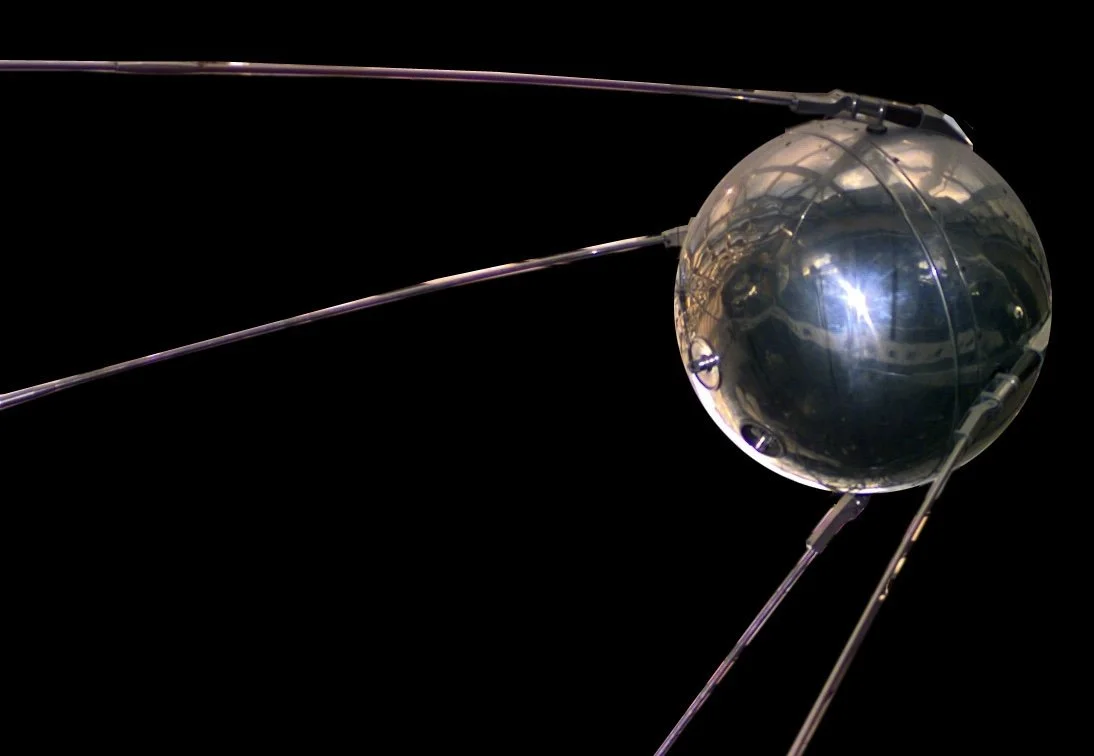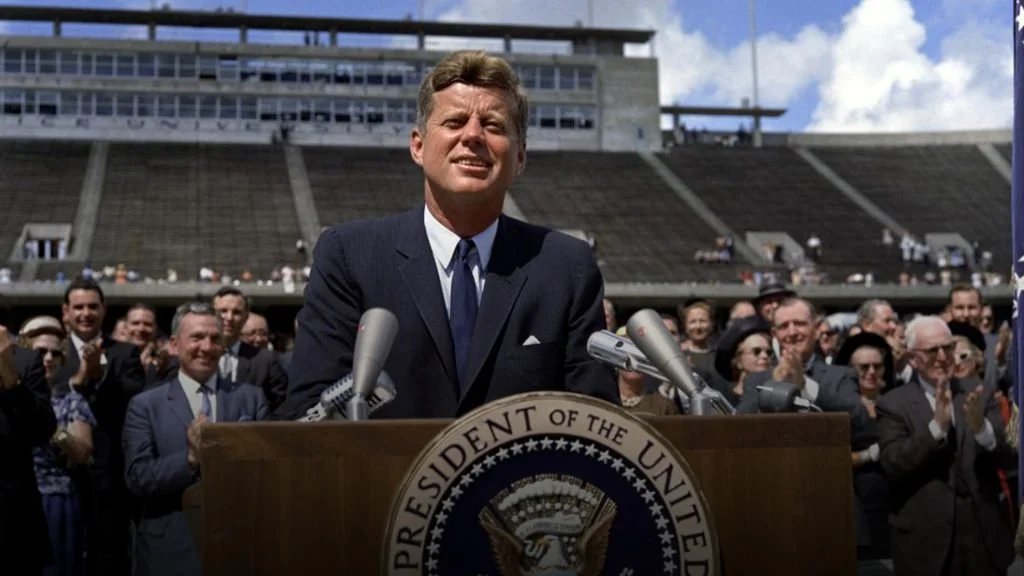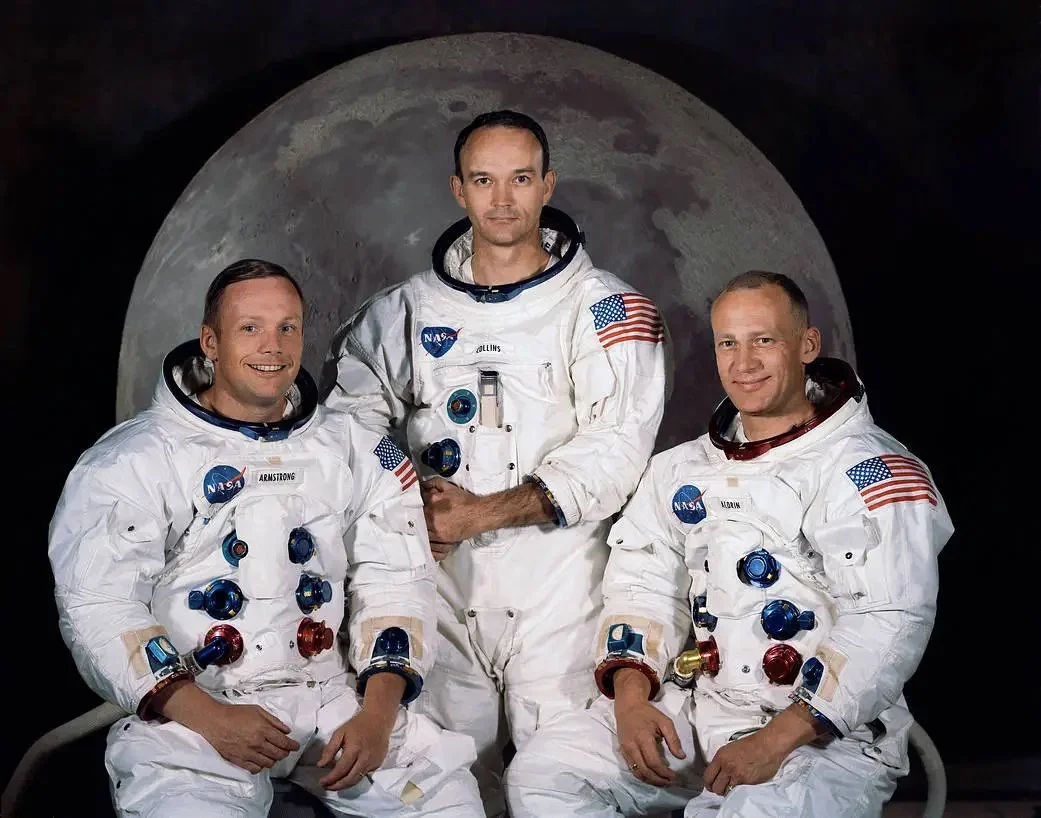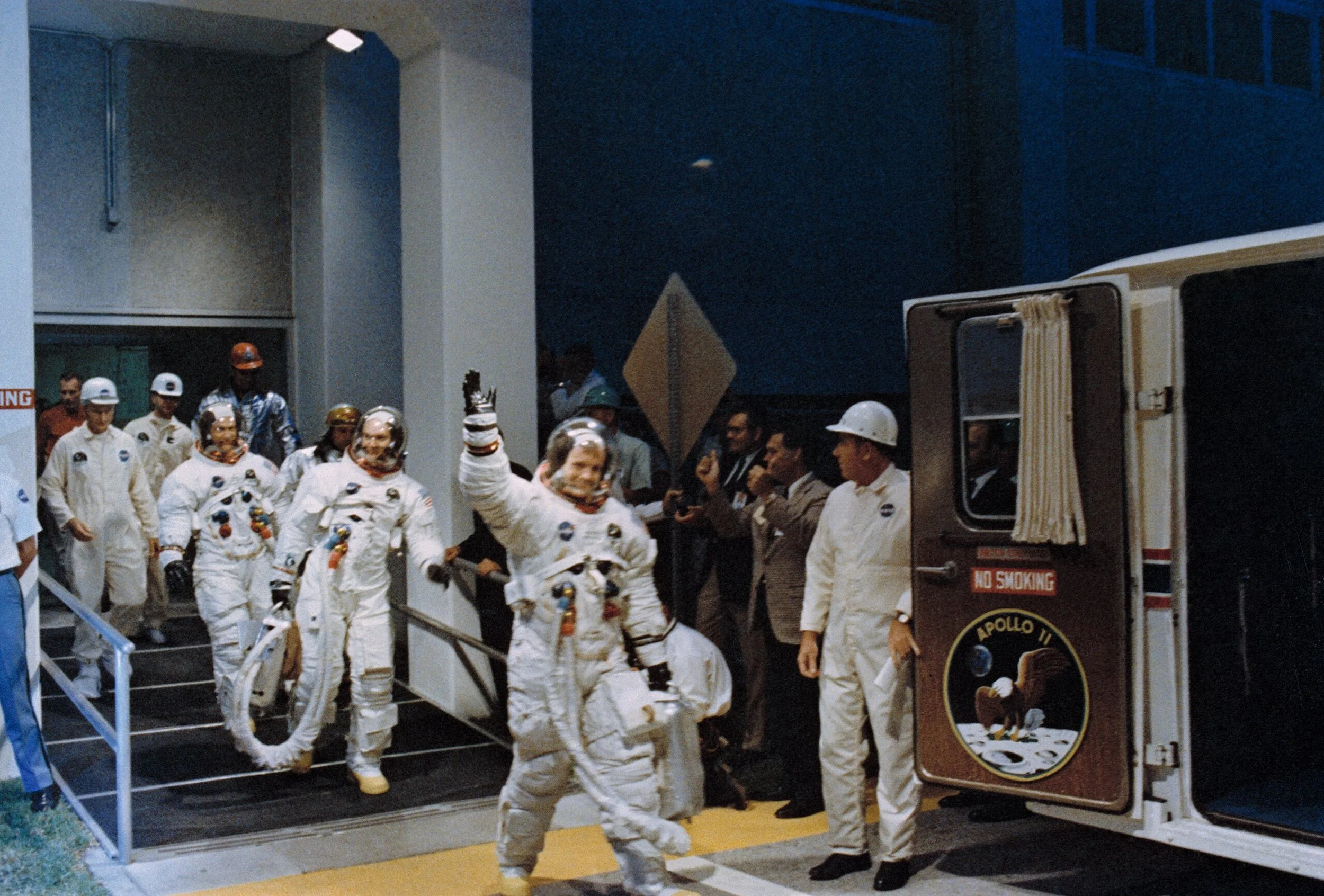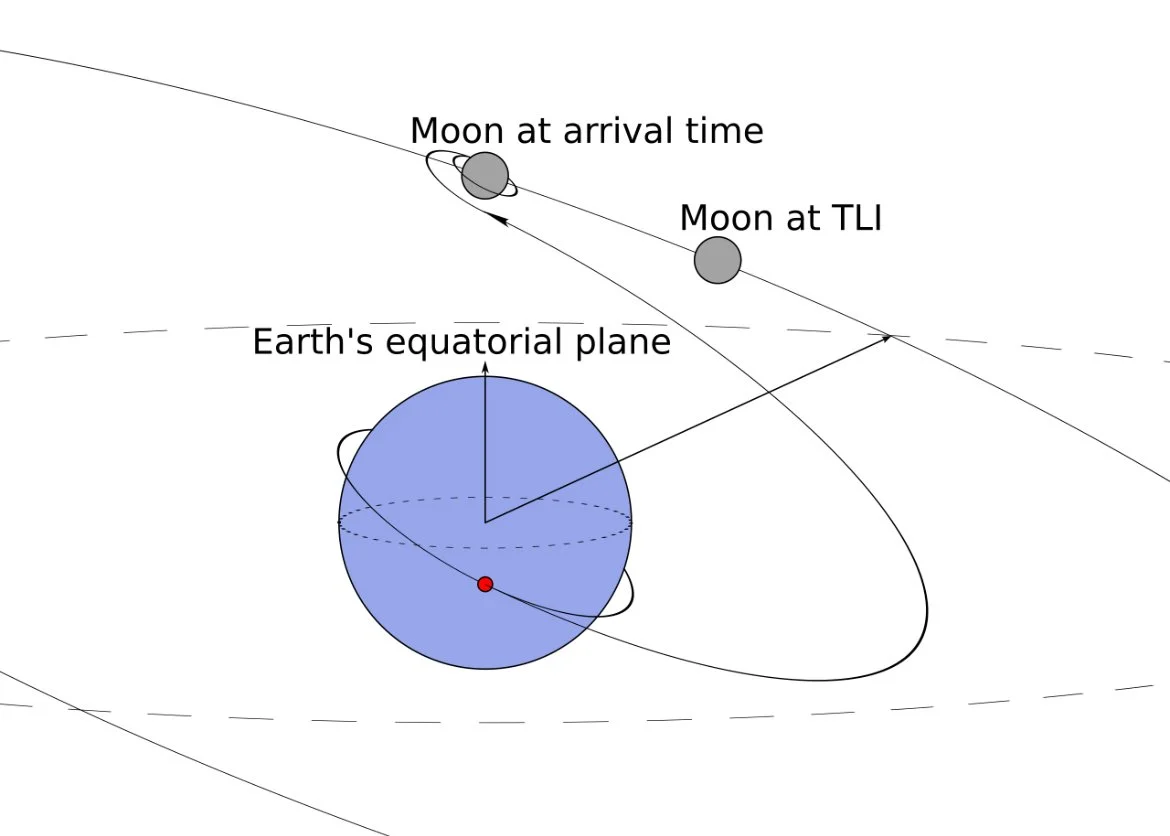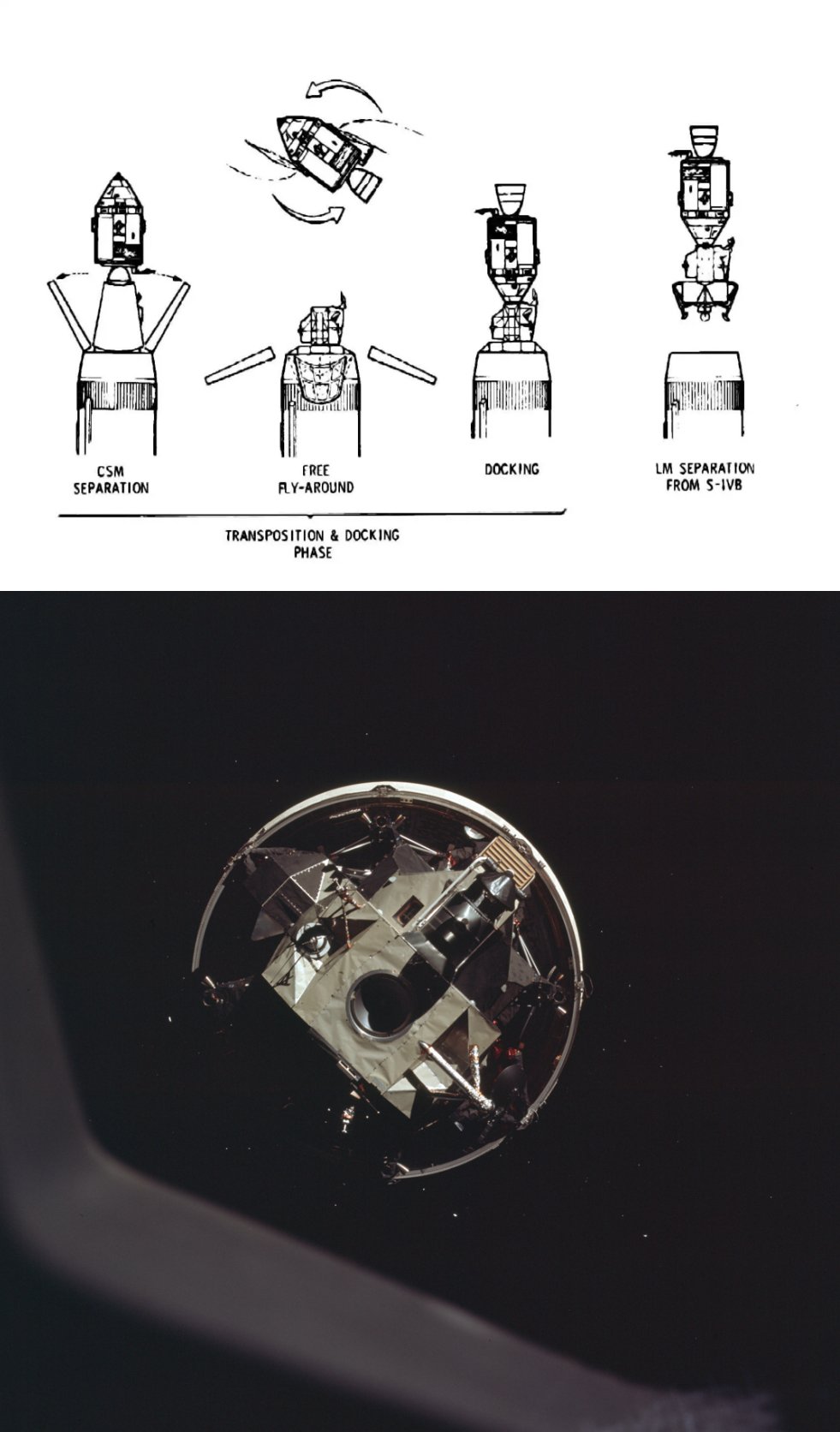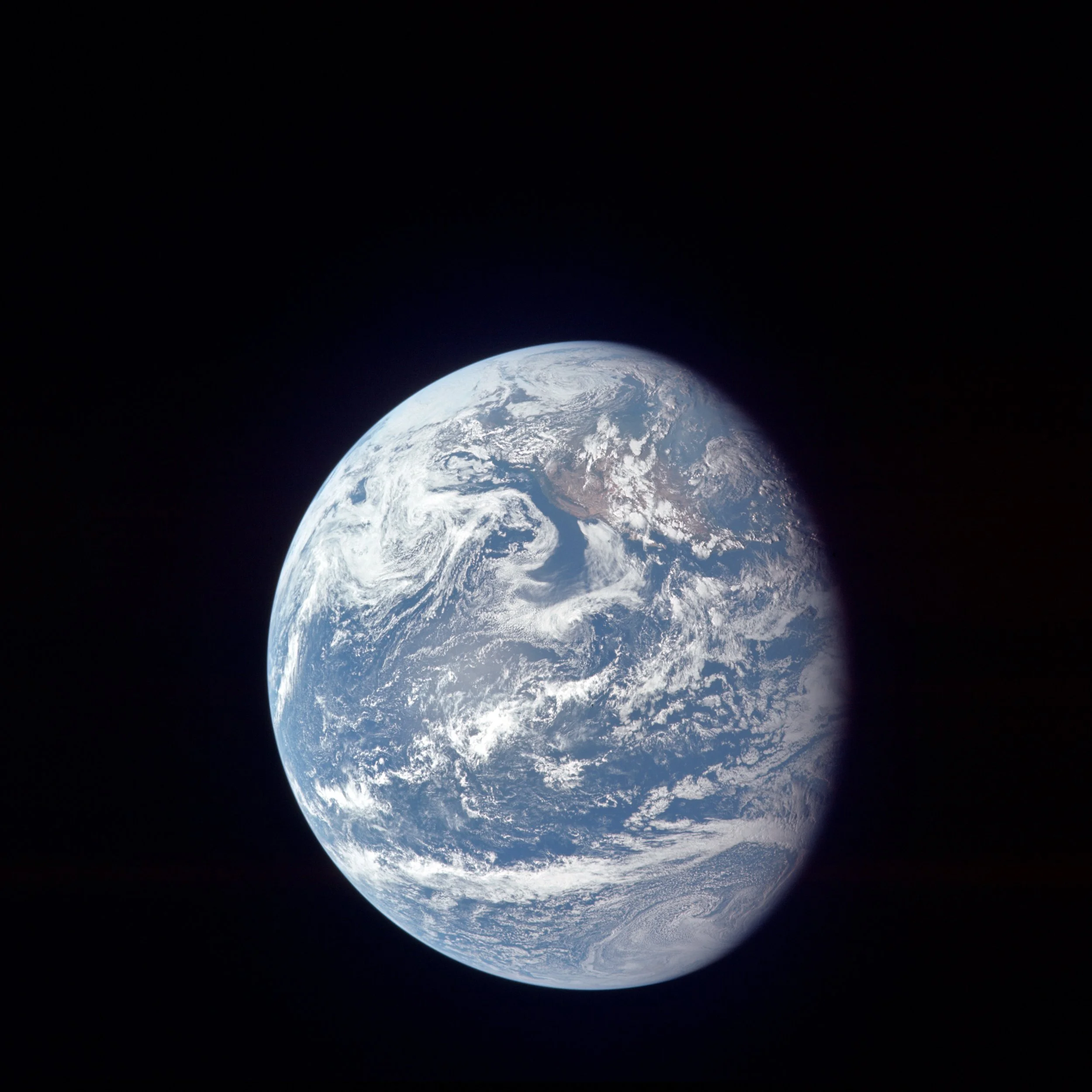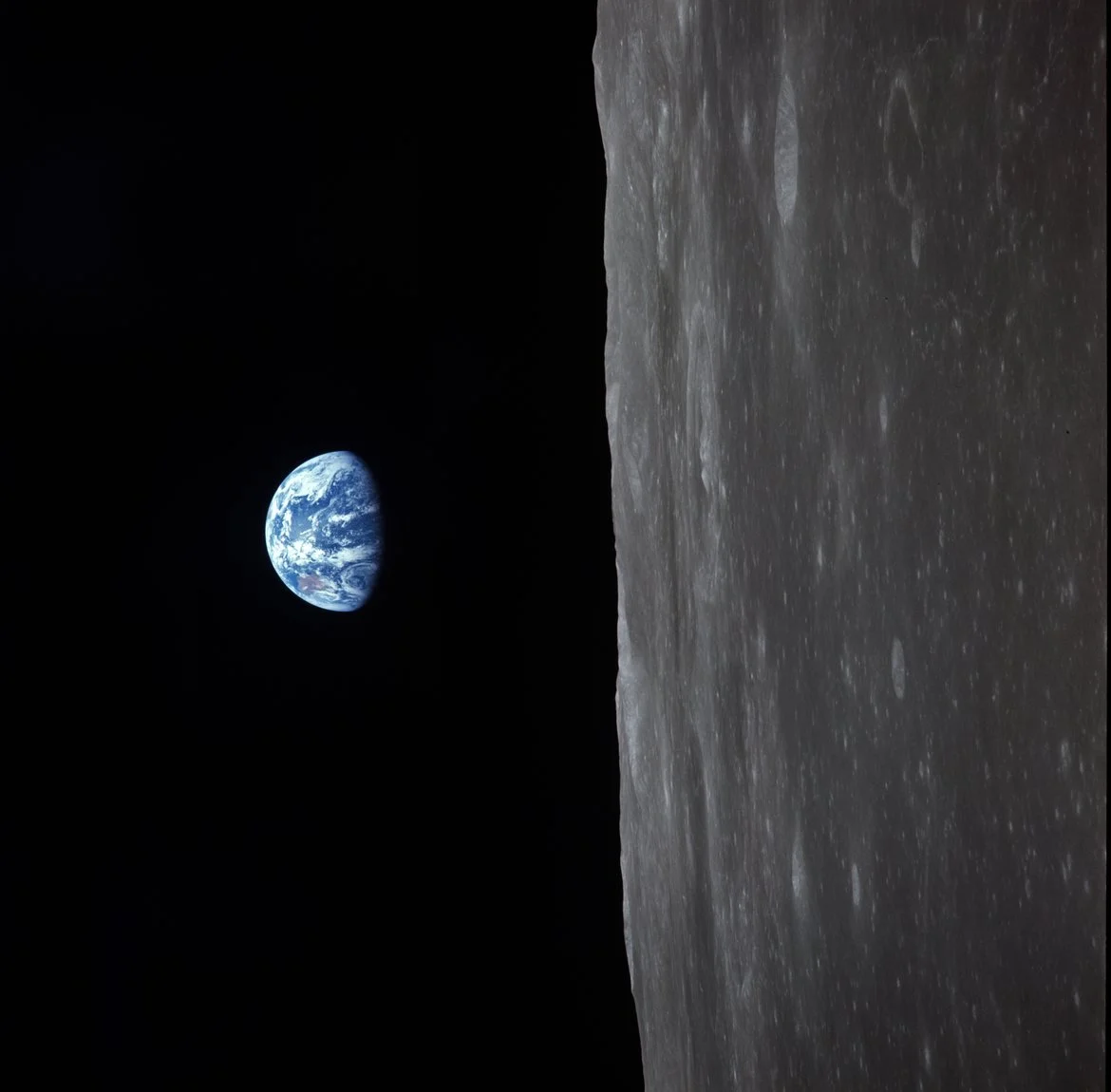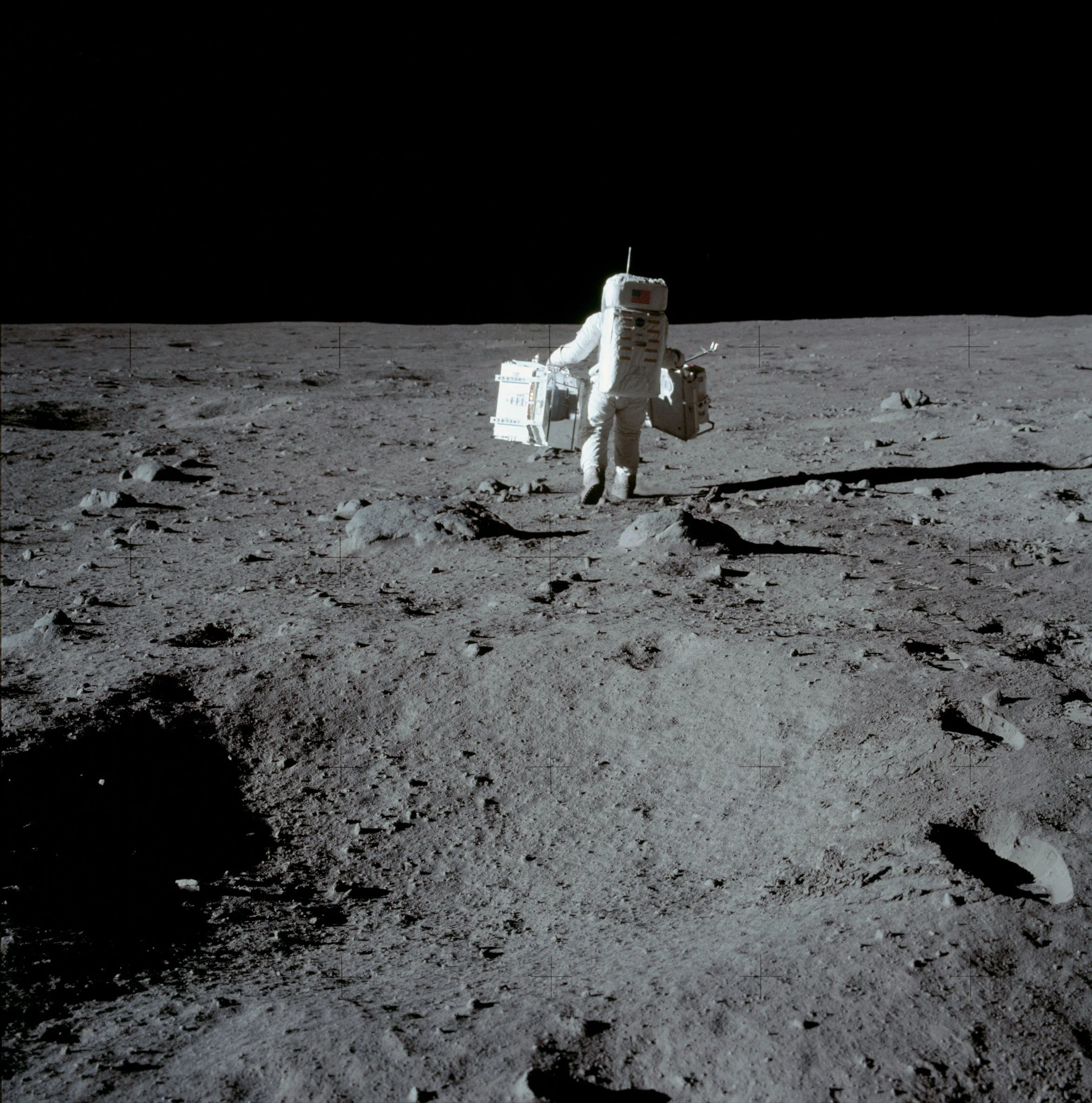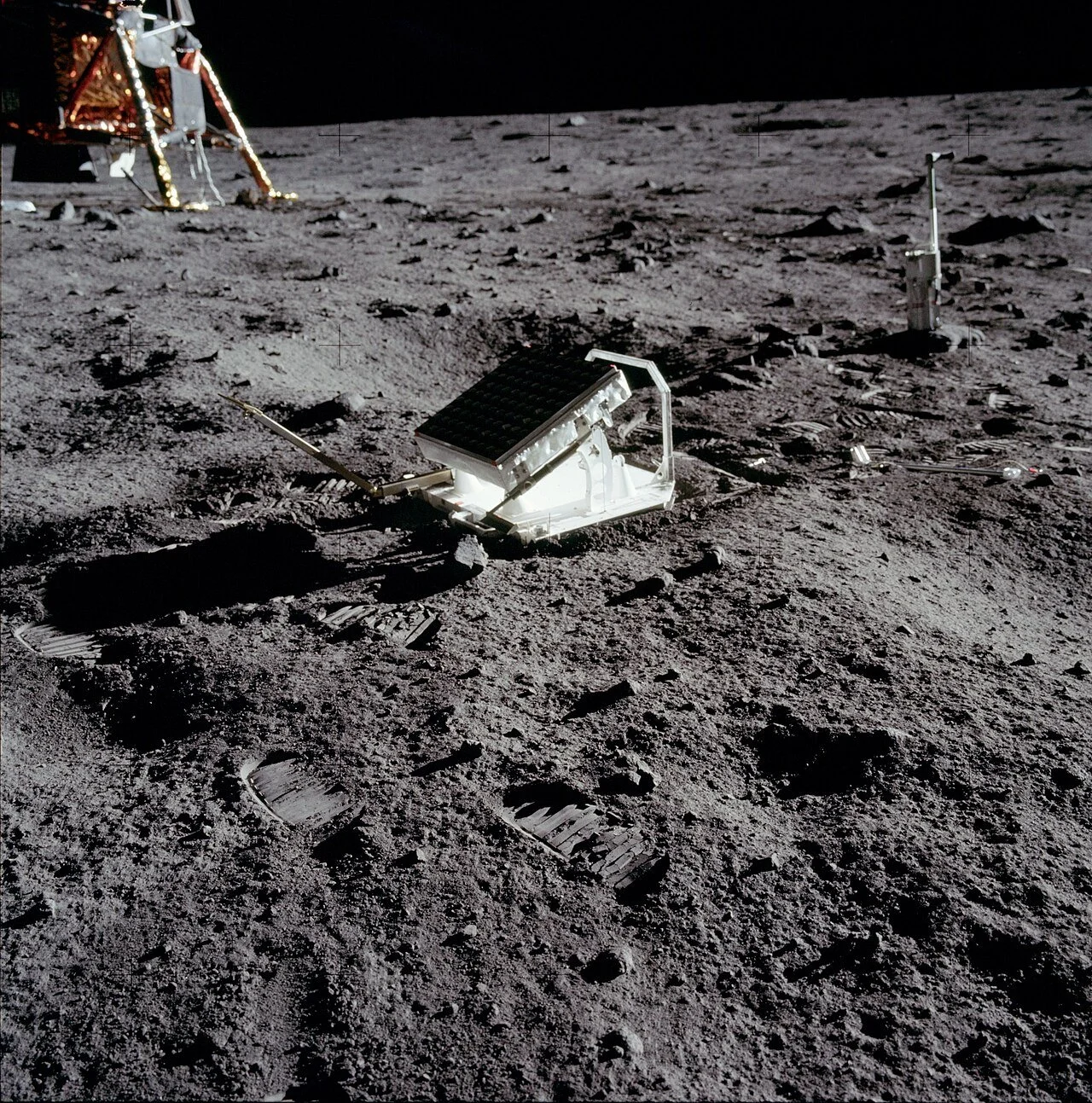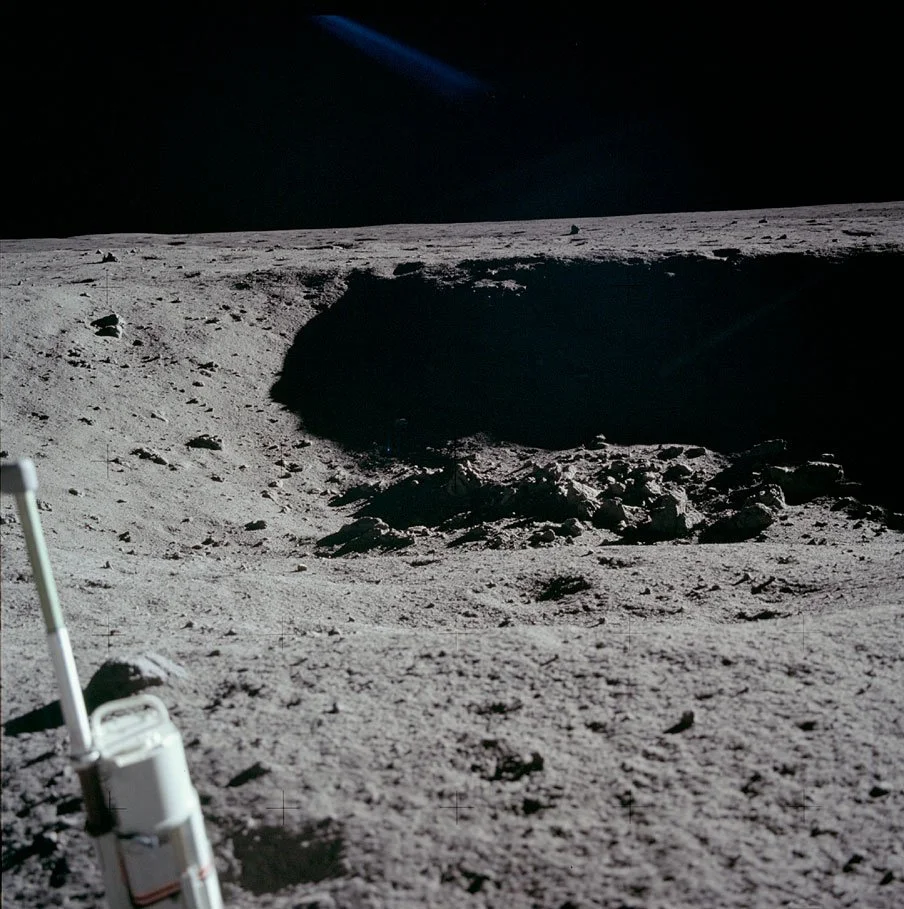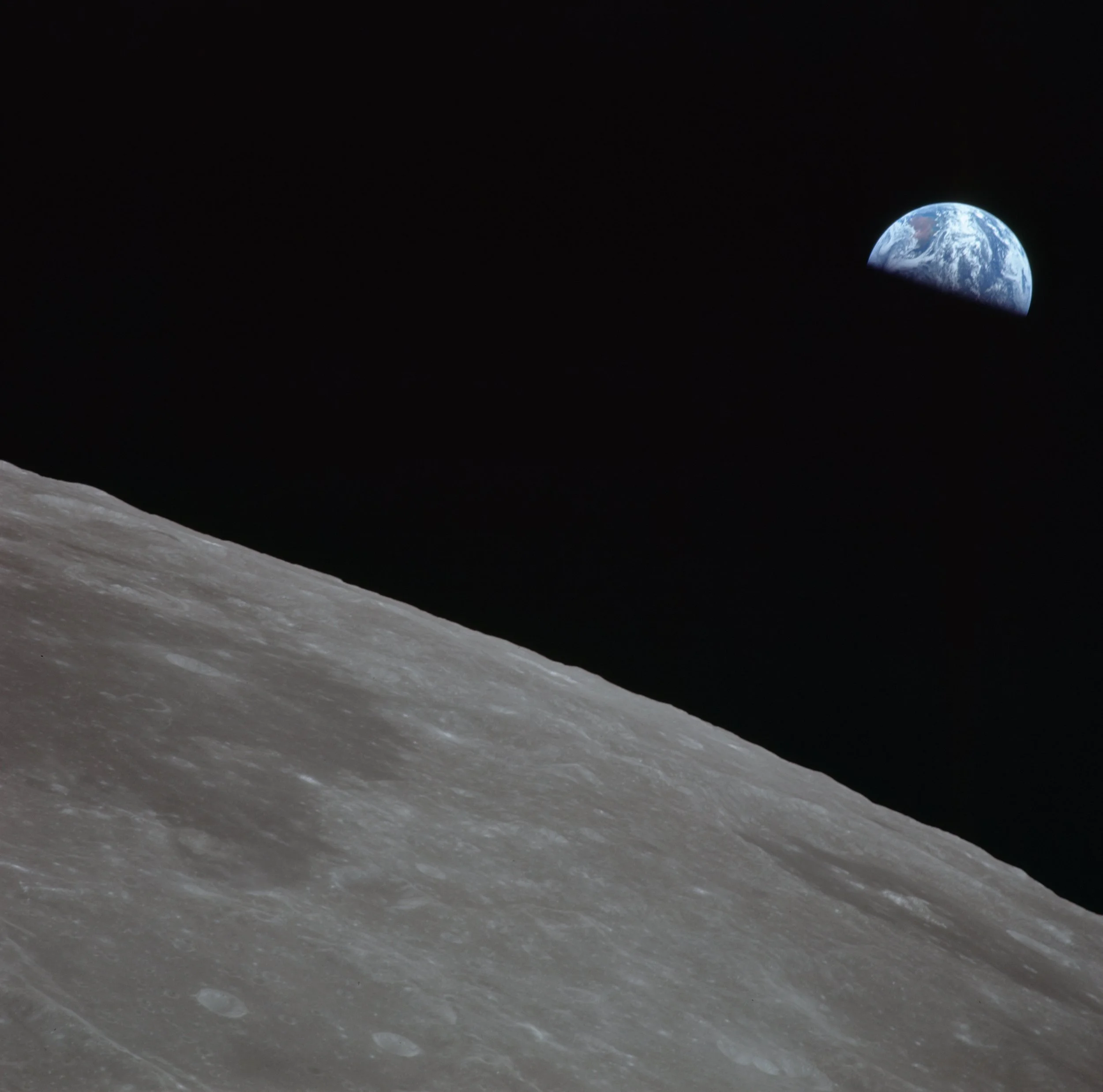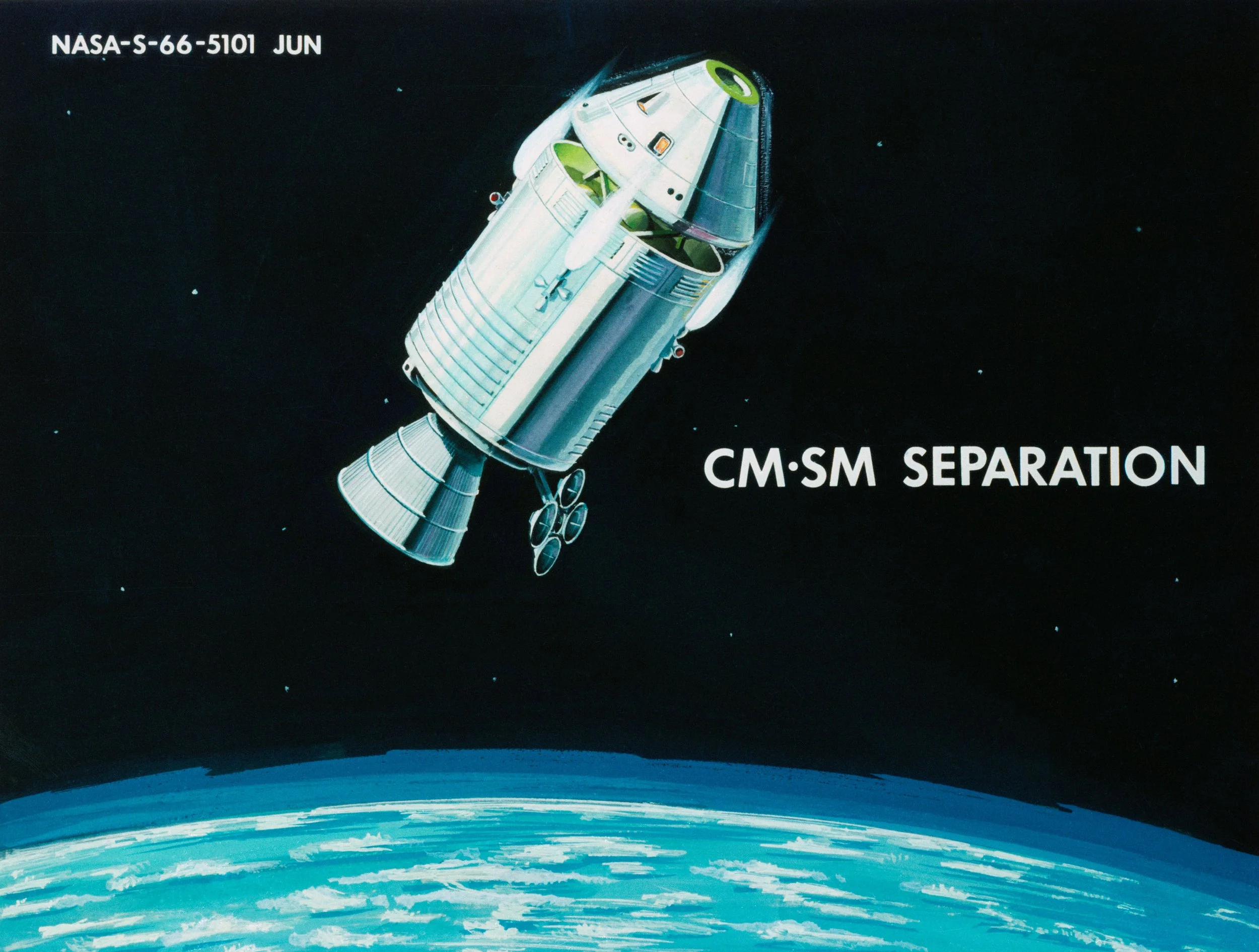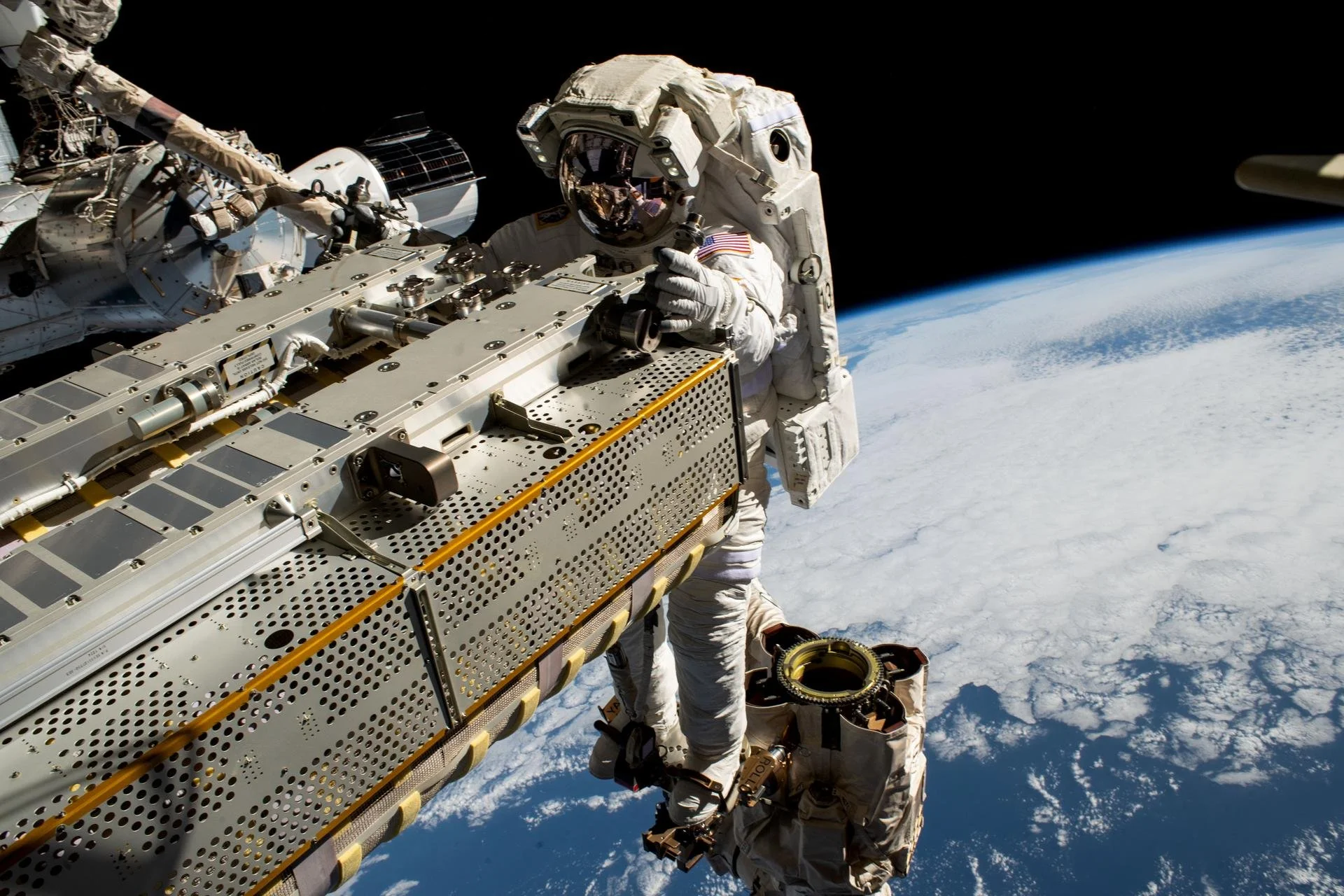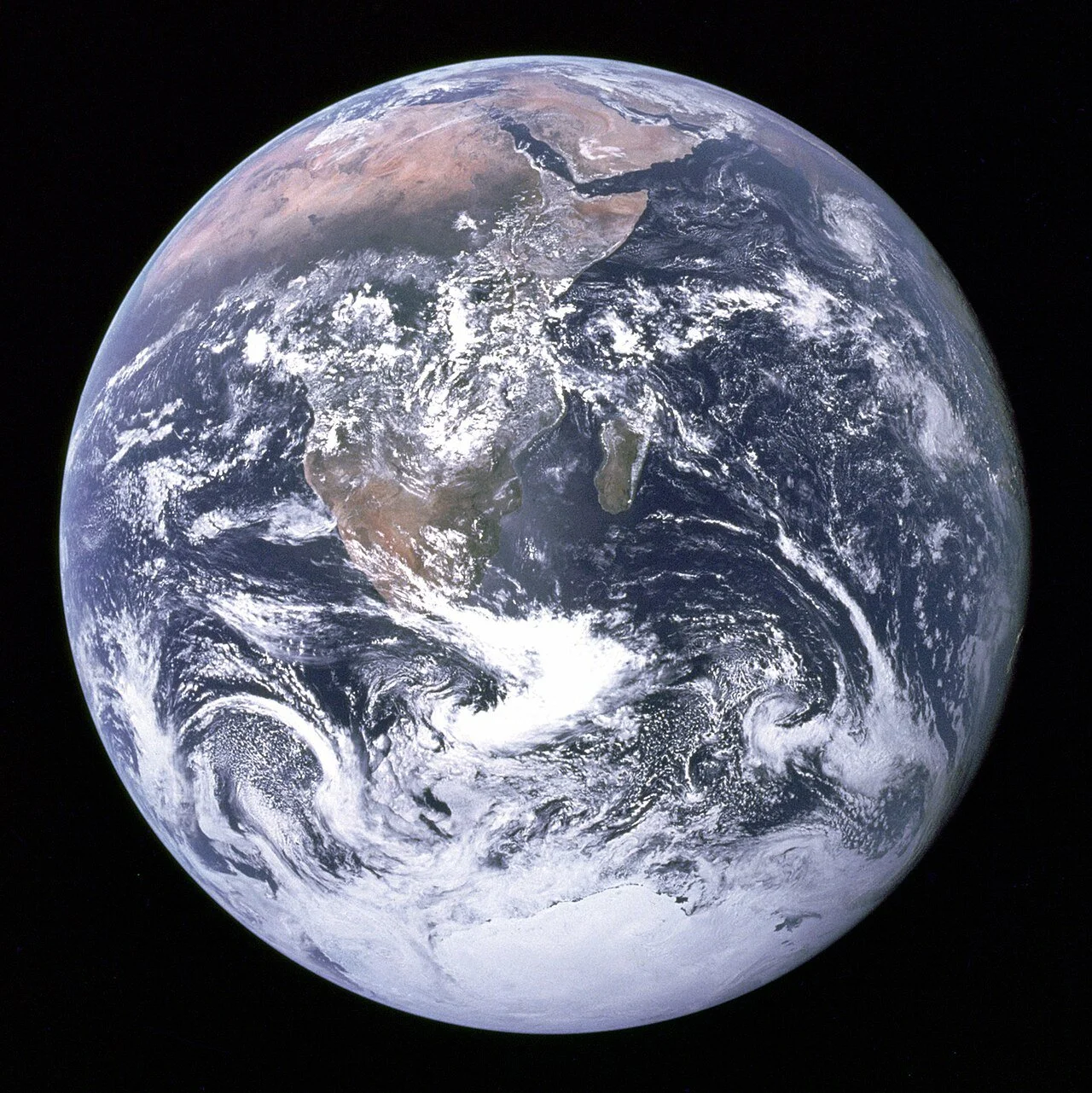The Apollo 11 Mission
by Sam Atkins
On July 16, 1969, humanity took a bold step forward into the great beyond of the cosmos. NASA launched the Apollo 11 mission which would carry three astronauts to the Moon. Four days later, Neil Armstrong and Buzz Aldrin would become the first humans in history to step foot on the lunar surface.
This article will chronicle this historic achievement in-depth, tracing the mission from its inception to execution to completion and taking stock of the ways in which it fundamentally transformed the political, economic and cultural zeitgeist as well as how it redefine our relationship with our own planet and the universe at large.
This article progresses across 11 sections:
The Space Race & The Apollo Program
Meet the Crew & Spacecraft of the Apollo 11 Mission
Launch Day
Trans-Lunar Injection
Lunar Orbit Insertion
Lunar Module Descent & Landing
Lunar Surface
Lunar Module Liftoff, Ascent & Docking
Trans-Earth Injection
Return to Earth
The Legacy of Apollo
Hopefully you enjoy the journey and gain an appreciation for the hard work and ingenuity that went into the early years of the human age of space exploration. Fair warning, the article is comprehensive, so if you are short on time, I have put together an abridged version of this article here: https://harfordastro.org/blog-4-1/the-apollo-11-mission-abridged-fs3k4
Note: Tap or hover over images for captions and credits.
The Space Race & The Apollo Program
In the wake and devastation of World War II, much of Europe was left to pick up the pieces of their destroyed homelands after years of bloodshed. However, the end of one global conflict gave rise to a new one. The United States had emerged as a new superpower representing Western values of liberalism and free enterprise. Meanwhile, the Eastern Bloc countries coalesced around the other great military power, the Soviet Union which represented state communism.
Tensions between the United States and the Soviet Union became the dominating world conflict through which international politics was centered around. A nuclear arms race had already begun as both superpowers started ramping up their respective stockpiles and the possibility of nuclear holocaust became a legitimate fear. For this reason, direct fighting was not an option either side sought, lest the whole world suffer the consequences. This instead became a war of proxies and competition. A cold war.
This struggle would extend across numerous frontiers but the most ostentatious was surely the frontier of space. Public interest in space travel had already taken root in the early 20th century with science fiction authors like H.G. Wells and real-world advancements in rocket science. By the 1950’s, with the Cold War stoking everybody’s patriotic fervor, there was no way either side could not act. In 1955, both the United States and the Soviet Union within days of each other declared their intentions to launch artificial satellites into Earth orbit. Thus began the Space Race.
In October 1957, the Soviet Union successfully launched the first artificial satellite into space, called Sputnik 1. Radio receivers around the world were able to pick up its beeping signal as it orbited the Earth for the next three weeks before burning up re-entering the atmosphere. Pictured above is a flight-ready backup of Sputnik 1 on display in the Cosmosphere in Hutchinson, Kansas. The aluminum sphere is 23 inches in diameter and housed all of the satellite’s electronics and mechanisms. The four antennae are each 12.8 feet long.
This historic achievement caught the United States by surprise and sparked a sense of urgency to shift significant resources towards science and technology. To add to the panic, in September 1959, the Soviet Union also launched the Luna 2 spacecraft which impacted the Moon and became the first human-made object to reach the lunar surface.
By the next year, the U.S. government had established the National Aeronautics and Space Administration (NASA) and Project Mercury. The objective was to achieve human spaceflight before the Soviet Union did. Despite U.S. efforts, the Soviet Union again beat them to it in April 1961 when the Vostok program successfully put the first human into space. Pictured above, Yuri Gagarin launched in the Vostok 3KA spacecraft and completed a full orbit around the Earth in just 108 minutes. A little over a month later, Alan Shepard became the first American in space. In February 1962, John Glenn became the first American to orbit the Earth.
The Apollo program was originally conceived in 1960 during the Eisenhower administration as a follow-up to Project Mercury. When John Kennedy was running for president, he was initially skeptical of the high costs and technological challenges associated with the Apollo program. Once he took office in 1961, he was persuaded by advisors and Vice President Lyndon Johnson to throw his full support behind it.
In May 1961, President Kennedy declared in a speech to Congress that America would land a human on the Moon and return him safely to Earth by the end of the decade. For this to be possible, NASA needed to build on the success of the Mercury program and develop long-duration spaceflight capabilities. This was the goal of Project Gemini. Between 1964 and 1966, twelve Gemini missions would launch into space to demonstrate the ability of astronauts to work outside of spacecraft. This was instrumental in paving the way for the Apollo program to achieve its goal by 1969.
The Apollo missions began with tragedy. In January 1967, there was a launch rehearsal for the AS-204 mission (later dubbed Apollo 1) planned for launch the following month. A cabin fire took the lives of all three astronauts and destroyed the command module.
In October 1968, 20 months after the tragedy, NASA resumed human spaceflight and the Apollo program’s first crewed flight, Apollo 7, successfully tested the command-service module in Earth orbit.
In December 1968, Apollo 8 successfully flew three men around the Moon. Borman, Lovell and Anders were the first humans to see the far side of the Moon and witness an Earthrise. Pictured above is Anders’ famous photograph taken during their third orbit around the Moon as the Earth rose over the lunar horizon.
In March 1969, the third crewed spaceflight launch with the full Apollo spacecraft which included the Saturn V rocket, the command-service module (CSM) and the lunar module (LM). This mission was flown to qualify the lunar module for lunar orbit and return from the lunar surface.
In May 1969, the Apollo 10 mission acted as a sort of “dress rehearsal” for the moon landing that was just two months away. All components and procedures of the Apollo spacecraft were tested in lunar orbit, other than the actual lunar descent and landing. It was almost decided that the Apollo 10 crew would make the attempt to land but ultimately was abandoned. That last part was going to have to be done for the first time by the Apollo 11 crew.
And thus the stage was set. It was finally time for the main event. Everything had been leading up to Apollo 11 set for launch on July 16, 1969.
Meet the Crew & Spacecraft of the Apollo 11 Mission
NEIL ARMSTRONG
Apollo 11 Commander
Born in Wapakoneta, Ohio. He worked as a civilian pilot and an aeronautical engineer before joining NASA in 1962. He would be part of the Gemini 8 mission in 1966. As mission commander, Armstrong was the leader of the mission and responsible for the safe and swift conducting of their objectives.
MICHAEL COLLINS
Apollo 11 Command Module Pilot
Born in Rome, Italy but grew up in the United States where he became an Air Force pilot. He was selected for NASA’s astronaut program in 1963 and served as a back up pilot for Gemini 5 and 7 and a pilot for Gemini X in 1966. As the command module pilot, Collins was responsible for maintaining lunar orbit and maintaining communications while Armstrong and Aldrin went down to the surface. Fun fact: Collins designed the Apollo 11 mission insignia.
EDWIN “BUZZ” ALDRIN JR.
Apollo 11 Lunar Module Pilot
Born in Glen Ridge, New Jersey. He flew 66 combat missions during the Korean War. He joined NASA as the first astronaut with a doctoral degree in 1963 and took part in the Gemini 12 mission in 1966. As the lunar module pilot, Aldrin’s job was to accompany the Mission Commander in the lunar module between the orbiting command module and the lunar surface. He would also accompany Armstrong on the lunar surface.
The crew selection was officially announced in November 1967, about twenty months before Apollo 11 was set to launch. They would spend hundreds of hours training on the Apollo command and lunar module at facilities that accurately simulated the lunar environment, learning all of the spacecraft’s functions, navigation and emergency procedures.
Armstrong and Aldrin received specialized training in facilities which used suspension harnesses and reduced-gravity chambers to simulate the Moon’s low-gravity environment (a sixth of the Earth’s gravity). They had to learn how to safely move between the cramped lunar module and the lunar surface while in their cumbersome spacesuits. They practiced walking, jumping and moving over uneven terrain in their spacesuits. They practiced all of the activities they would perform on the Moon such as rock sample collection and instrument deployment. All of this done in spacesuits for hours would require significant physical strength and stamina so they had to be in peak physical condition throughout.
APOLLO 11 SPACECRAFT
The Apollo 11 spacecraft was made up of three main components: the command module, the service module and the lunar module.
The COMMAND MODULE, named “Columbia,” was a truncated cone of aluminum which capped off the top of the rocket and housed the three astronauts on their lunar voyage. It was less than 13 feet in diameter giving the men minimal room to maneuver. Inside was access to all of the spacecraft’s life support, navigation and communications systems. The base of the command module acted as an ablated heat shield which would protect the astronauts during re-entry into Earth’s atmosphere at the end of the mission.
Attached to the nose of the command module is the Launch Escape System (LES) which consisted of a relatively small solid-fuel rocket. In the event of a launch or ascent emergency, such as an explosion, the LES could yank the command module away from the rocket and potentially save the astronauts from harm.
The SERVICE MODULE was an aluminum cylindrical unit about 12 feet wide and 24 feel long. It attached to the back of command module. Once the Saturn V rocket was detached, the service module acted as Apollo 11’s primary propulsion system to maintain lunar orbit and later get the astronauts back to Earth.
The LUNAR MODULE, named “Eagle,” was stowed between the service module and the rest of the Saturn V rocket at launch. It was an 18 feet tall, 13 feet wide insect-like pod with four retractable legs and was parted into two stages (similar to the Saturn V rocket). Its job was to safely transport Armstrong and Aldrin from the command module to the lunar surface and back.
The Apollo spacecraft was mounted at the top of the launch vehicle, a Saturn V rocket.
SATURN V ROCKET
The Apollo 11 launch vehicle was a Saturn V rocket developed by the German scientist Wernher von Braun. The rocket’s job was to reach escape velocity (11 kilometers per second) and get the Apollo spacecraft into Earth orbit.
At 110 meters tall (36 stories) and 10 meters in diameter, the Saturn V is to this day the largest and most powerful rocket ever put into orbit (though SpaceX’s Starship may soon unseat it). It was primarily made of aluminum which is lightweight, strong and resistant to corrosion and thermal expansion. It was a liquid fuel rocket which when fully-fueled weighed 6.5 million pounds. Approximately 85% of that weight was the propellant, consisting of liquid hydrogen (fuel) and liquid oxygen (oxidizer) which would be combined, combusted and forced out of the engines to produce thrust.
The rocket was segmented into three “stages,” one stacked on top of the other. The first stage at the bottom was to burn its highly-refined kerosine fuel and then detach from the rest of the rocket, then the second stage would take over. The second and third stage used liquid hydrogen fuel but all three stages used liquid oxygen for an oxidizer. Separating into stages allowed the rocket to gradually shed unnecessary weight as it expended its fuel and each stage could be optimized for its specific role.
As of 2025, the Saturn V rocket remains the only rocket to ever carry humans beyond low-Earth orbit.
Launch Day
July 16, 1969
VEHICLE ARRIVAL & ASSEMBLY
Due to their significant size and weight, the various stages of both the Apollo 11 spacecraft and Saturn V rocket arrived separately to the Kennedy Space Center on Merritt Island, Florida throughout early 1969. Two stages of the rocket were so big they had to be transported by barge from New Orleans where they were built. The spacecraft and rocket were later assembled and stored in the Vehicle Assembly Building to undergo maintenance and await the mission.
PREPARATION
In the early morning hours of July 16th, the Saturn V rocket waited on the launch pad while its fuel tanks were filled. The astronauts awoke at 4:00a.m. to shower, shave and eat breakfast before donning their spacesuits. At 6:30a.m., the astronauts headed out to Launch Complex 39 to board the Apollo spacecraft. The three were seated side-by-side with their backs towards the ground. The hatch was sealed and the cabin was purged of the outdoor air and repressurized with pure oxygen gas. When all checks were completed, a three minute and twenty second countdown began.
LIFT-OFF
At 9:32 a.m. EDT, the Saturn V rocket carrying Neil Armstrong, Buzz Aldrin and Michael Collins fired its engines. Brilliant flames rushed from the engine nozzles, reaching temperatures of 1,400°C (2,500°F) and charring the landing pad below. The flames were accompanied by a deafening deep growl and large rolling plumes of white smoke swept across the landscape, visible from miles away. The rocket lifted off the launch pad, producing 7.5 million pounds of thrust.
You can watch the Apollo 11 launch here (BBC America):
ASCENT
The first stage had the most powerful engines as it had to overpower the full weight of the rocket, which fully-fueled was about 6.5 million pounds. As the rocket soared high above the Floridian coast, the crew remained in constant contact with Mission Control throughout the ascent. The rocket rolled and pitched to achieve the correct trajectory for Earth orbit.
The first stage burned for two minutes and 44 seconds reaching almost 6,146 miles per hour (9,916 kilometers per hour). By this point they were well above the clouds and the crew was pulling 4 g’s. This would be the most g-force they faced until the end of the mission upon re-entry of Earth’s atmosphere at 6 g’s. The first stage was spent, shut down and jettisoned from the rest of the rocket. It would soon would plunge into the Atlantic Ocean hundreds of miles off the coast. The Launch Escape System (LES) at the nose of the Apollo 11 spacecraft was also jettisoned at this time.
Seconds later, the second stage was fired, producing 1 million pounds of thrust. Nine minutes after launch, they reach 100 miles (161 km) in altitude. They were almost into Earth orbit moving about 15,700 mph (25,260 km/h) and just needed a little more push to get there. After six and a half minutes, the second stage was shut down, separated and fell into the ocean.
The Saturn V’s third and final stage was ignited. This only lasted another two and a half minutes, enough to put them into a near-circular Earth orbit.
EARTH ORBIT
At 9:44a.m. EDT, twelve minutes after liftoff, the Apollo 11 spacecraft was 115 miles (186 km) above the Earth’s surface moving at a steady 17,500 mph (28,160 km/h). It would perform one and a half orbits around the Earth while the crew took photographs and checked the various spacecraft systems to ensure they were ready for the long voyage to the Moon.
Translunar Coast
July 16, 1969
TRANSLUNAR INJECTION
After the Apollo 11 crew had performed one and a half orbits around the Earth, it was time for the translunar injection. This was the propulsive maneuver that would send the Apollo 11 spacecraft out of Earth orbit and towards the Moon.
At 12:16p.m. EDT, two hours and 44 minutes after lift off, the Apollo 11 ignited the third stage of the Saturn V rocket for a second burn. This was guided by the spacecraft’s onboard guidance computer which received input from various sensors and instruments, including an inertial measurement unit. This allowed the computer to monitor the spacecraft’s position, velocity and orientation. It also received supplemental data from ground-based tracking and telemetry data from NASA’s worldwide network of stations featuring large antennae. The burn lasted nearly six minutes with the rocket reaching incredible speeds of 25,000 mph (40,000 km/h). The Apollo 11 spacecraft entered into a long, extended ellipse around the Earth. Its trajectory was arranged such that the Moon would later gravitationally intervene and cause them to loop around the far side.
Armstrong commented, “Hey, Houston, Apollo 11. That Saturn gave us a magnificent ride.” The Apollo 11 crew was finally on their way to the Moon.
TRANSPOSITION, DOCKING & EJECTION
Having left Earth’s vicinity, Apollo 11 was coasting towards the Moon at 25,000 mph (40,000 km/h). This speed would gradually slow throughout their three day journey. The third and final stage of the Saturn V rocket had successfully completed its objectives. It was no longer needed and they would continue on without which required a somewhat complex process.
At 12:49p.m. EDT, the back of the command service was decoupled from the lunar module which was housed between it and the third rocket stage. At the same time, four panels forming a conical shell around the lunar module were jettisoned, exposing it.
Once free, Collins manually thrusted the CSM forward at 100 feet per second using the CSM’s own propulsion system. Collins rotated the CSM around by 180° so that the nose was facing the lunar module, which you can see pictured above. The CMS moved forward slowly so that the nose of the command module could dock with the lunar module. Collins used a left-hand docking window with a reticule pattern that helped him guide the probe at the nose of the command module into the roof of the lunar module.
To separate the lunar module from the third stage, the crew had to reach and connect two electrical umbilicals inside the tunnel that lies between the now-connected lunar module and command module. However, the lunar module was depressurized during their ascent into space so in order to enter the lunar module through the tunnel between them, they had to wait for it to re-pressurize first.
At 1:48p.m. EDT, the lunar module was detached from the third and final stage of the Saturn V rocket. At 2:12p.m., the CSM’s propulsion system burned for three seconds to move a safe distance away from the now-abandoned rocket stage and be set on the remainder of their voyage to the moon.
At 2:38pm, the rocket stage’s auxiliary propulsion thrusters were fired one last time. The stage would be propelled on a trajectory, at a slower speed so as not to tempt collision with Apollo, to pass over the trailing edge of the moon. The rocket stage will gain extra velocity imparted by the moon’s gravity and be flung into a solar orbit where it remains to this day.
HOUSEKEEPING & TELEVISION BROADCAST
The hard part of the day was over. The crew performed some routine system checks and navigation tasks. One such task involved Collins taking multiple angular measurements between a background star of his choosing and the moving disk of the Earth.
Ten hours had passed since Apollo 11 left Earth’s surface. Before retiring for the night, the Apollo 11 crew participated in a recording for an unscheduled television transmission showing views of the Earth from their windows which would soon be broadcast to the world. The transmission would last 15 minutes but many channels kept the footage on repeat for all to see.
The television transmission can be seen here:
Afterwords, the crew got some lunch and said goodnight to Houston at about 10:18p.m. EDT. The Apollo 11 spacecraft had 286,000 km to go and was set to enter into lunar orbit on July 19th. Over the next few days, the crew would continue their system checks, trajectory realignments, photographing Earth and more television transmissions. They even performed an experiment where they tried to observe a laser pointed at them from Texas.
Lunar Orbit Insertion
July 19, 1969
LUNAR MODULE PREPARATION
Ahead of their arrival to the moon, 55 hours into their mission and 85% of the way to the moon, Armstrong and Aldrin entered into the lunar module through the tunnel connecting from the command-service module. At the time, the Apollo 11 spacecraft had slowed to 2,145 mph (3,450 km/h) and was soon to cross into the moon’s sphere of gravitational dominance. Armstrong and Aldrin filmed their entry which was broadcasted on television. Pictured above is Aldrin inside the lunar module.
You can see video of their entry into the lunar module and performing preliminary checks here:
https://youtu.be/gtxyB0h2V3g?si=vg-tEneipTmgXkkq
After the crew had finished preparations on the lunar module and last-minute flight updates were concluded, the crew went down for another scheduled sleep period.
LUNAR ORBIT INSERTION
While the Apollo 11 crew slept, the command-service module entered into the gravitational dominance of the moon. The spacecraft was now falling towards it, accelerating under its gravitational pull. Upon their waking on July 19th, the command-service module entered into the moon’s shadow. By this point, the moon appeared about 20 times larger than it does from Earth. For a short time, the crew could see star constellations and the Sun’s corona for the first time.
As the Apollo 11 spacecraft rounded the far side of the moon, mission control lost radio contact which was expected to happen but would leave much of the control room in silent anticipation. It was time to perform the lunar orbit insertion maneuver. Their speed had been increasing due to the moon’s gravity and would need to slow down to not overshoot the moon. This would require a retrograde burn in which the spacecraft was turned around so that the service module’s propulsion system was facing forward.
Before beginning the lunar orbit insertion, the crew took a moment to marvel at the lunar surface which was only 570 km or so away. At 1:22p.m. EDT, they initiated a six minute burn which thrusted against their forward motion and dramatically slowed their speed. Rather than achieve a circular orbit in one burn, it was decided for safety reasons to cut the burn short by 17 seconds which allowed the spacecraft to enter into a more elliptical orbit. From here, they would have a few orbits to determine its shape and calculate the appropriate length of a second burn that would put them into a circular orbit. While waiting for the second burn they participated in another television transmission.
As they passed behind the far side of the moon again, beginning their third orbit, they initiated a second, shorter 17-second burn which slowed them down a bit more and put them into a roughly circular orbit at 120 km above the lunar surface.
LUNAR ORBIT
They had entered into a circular orbit with an altitude of 110 km and an orbital period of roughly two hours, with 48 minutes of each revolution spent out of radio contact due to being blocked by the moon. The Apollo 11 spacecraft continuously passed over the intended landing site within the Mare Tranquillitatis region on the near side of the moon. The crew would observe and study surrounding lunar surface features they would use as navigation aids during the next day’s descent. Armstrong and Aldrin also made their second entrance into the lunar module to transfer equipment and perform more systems checks.
The Apollo 11 crew went off comms for sleep at 12:04a.m. EDT on July 20th.
Lunar Module Descent & Landing
July 20, 1969
EAGLE SEPARATION
At 8:52a.m. EDT, Aldrin and Armstrong enter into the lunar module through the tunnel that connects it to the command module. They power it up and deploy the landing gear.
At 1:44p.m. EDT, the lunar module separated from the command module. From here on out the separated modules would go by different call signs: the lunar module was “Eagle” and the command-service module was “Columbia.” Armstrong rotated Eagle so that Collins could inspect it from Columbia to ensure the landing pads were properly deployed.
You can watch the lunar module separation filmed by Collins here:
PREPARATIONS FOR DESCENT
Buzz began filming the Columbia as Eagle gained altitude. The two halves would soon enter into separate orbits as the Eagle crew calculated their imminent powered descent. The timing of the burn was vital as burning for too long would result in crashing into the lunar surface.
DESCENT ORBIT INSERTION
The Eagle lander was pitched (tilted back) so that the descent engine was facing forward for a retrograde burn.
The purpose of the descent orbit insertion maneuver was to reduce speed and put the Eagle lander into a much tighter orbit around the moon, with 15 km being the target altitude for perilune (like perihelion but for the moon instead of the Sun). From this lower altitude, they could begin their powered descent to the surface.
At 3:03 p.m., the Eagle lander ignited a burn of its descent propulsion system from the far side of the moon which would last approximately 30 seconds at 9,800 pounds of thrust. As they rounded the far side of the moon for the 13th time and their altitude dropped, the Eagle lander pulled ahead of the Columbia.
At this point, a significant crowd had gathered in the viewing room back in Houston, including high officials like NASA’s Administrator Thomas Paine and famous astronauts like John Glenn. The moment of truth was fast approaching and the tension was palpable.
POWERED DESCENT INITIATION
The powered descent initiation maneuver would begin 15 km above the surface and 500 km east of the planned landing site. The Eagle landers engine was ignited and the maneuver would last about twelve and a half minutes, split into various phases.
The first phase of the powered descent, called P63 or the Braking phase, was automated by the onboard computer and meant to provide an efficient reduction in speed. This would last the longest at about nine minutes.
The Eagle lander regained line of sight with Earth and radio contact with Houston who at this point noticed a problem. The Eagle lander was descending faster than it was supposed to. This was later attributed to the placement of metal sheets below the lander’s maneuvering thrusters which were meant to protect the lower section from their heat. Unfortunately, they were interfering with the lander’s dish antennae which was guiding their navigation. It was also suspected that excess air pressure in the docking tunnel may have given the Eagle lander an unintended boost when it separated from Columbia.
Looking through his downward facing window, Armstrong could tell that they were reaching landmarks seconds earlier than anticipated as well. He rotated the lander around so that the opposite-facing landing radar could point at the surface and feed them accurate navigation data.
With three minutes remaining and an altitude of about 2.2 kilometers, the Eagle lander entered the next phase of its powered descent, called P64 or the Approach phase. The lander would continue to slow while pitching forward to a more upright position (about 40°). This allowed the crew to see the landing site ahead through their windows. At this point, they would normally be studying the lunar surface to gauge where they would touch down but Armstrong and Aldrin were fully-focused on whether they could land at all amidst a series of alarms that had started blaring in the cabin.
As if things weren’t tense enough, it became apparent that the Eagle lander was running low on fuel. If it got too low, the lander was programmed to initiate an abort sequence by dumping the descent stage and blasting off with just the ascent stage. This would have prevented any future attempts to land on the surface. The stakes were high.
LANDING
When the Eagle lander reached below 0.6 km, Armstrong was finally able to take time to scan the horizon. Judging by their speed and recognizable landmarks, he knew that they would miss their landing site by at least three miles (ultimately they missed it by four). They had to improvise and scour the surface for a new landing sight.
Looking ahead, he saw a football field-sized crater which was later identified as West Crater. The surface around the crater was littered with boulders up to 2-3 meters in size. They had to decide quickly whether they would land short of various boulders, move around them, or fly over them. The last option seemed the easier and more natural one. However, the Eagle lander’s fuel was dwindling fast but they weren’t paying attention to that as much as Houston was. Armstrong took back manual control of the Eagle lander and overflew West Crater.
Armstrong and Aldrin continued to scan the surface pointing out possible landing sites as they descended to within 500 feet of the surface. Armstrong said, “Here’s a… looks like a good area here.” Here, they entered the third and final phase of the powered descent, P65 or the Landing phase. The Eagle lander was pitched nearly upright (less than 10°) and manual control was restored to Armstrong where he would lower it like a helicopter.
Aldrin commented that he could see the lander’s shadow on the surface. Houston reminded the Eagle crew they had 30 seconds of fuel remaining. As they closed the distance, lunar dust rushed outward in every direction from below the descent engine’s thrusting flames. Without any real atmosphere on the moon to speak of, instead of rolling upward, Aldrin later recalled the dust simply drifted over the horizon.
The Eagle lander finally contacted the ground surprisingly smoothly and Armstrong shutdown the engine at 4:17p.m. EDT. After a few moments of checking systems, Armstrong gave Houston the relief they had been desperately waiting for.
Armstrong: “Houston, Tranquility Base here. The Eagle has landed.”
Houston: “Tranquility. We copy you on the ground. You got a bunch of guys about to turn blue. We're breathing again. Thanks a lot.”
You can experience the harrowing final minutes of the Apollo 11 lunar descent for yourself here:
Lunar Surface
July 20, 1969
POST-LANDING CHECKLIST
Shortly after landing, Aldrin described the landscape to mission control, such as the types and sizes of rocks and the general color of the surface.
While Armstrong and Aldrin were no doubt enraptured by the anticipation of being mere steps from the lunar surface, there was still much to do. They would remain in the Eagle lander for over six hours after landing. It was supposed to be longer to include a several hour recovery period but both were too excited to sleep and skipped it.
The first thing they needed to do was ensure that they were not stranded on the moon. They went over their post-landing checklist to ensure the lander was safe and functional after touching down and began a simulated countdown for takeoff. Preparing the lander to leave would take about a few hours.
Skipping the sleep period, they asked permission to start extra-vehicular activities (EVA) four hours early and it was granted.
Shortly before beginning preparations to exit, Aldrin radioed to Earth: “This is the LM pilot. I'd like to take this opportunity to ask every person listening in, whoever and wherever they may be, to pause for a moment and contemplate the events of the past few hours and to give thanks in his or her own way.” He then took communion privately, the first religious practice performed on the moon.
The crew cabin of the Eagle lander was cramped and cluttered with supplies, so donning their spacesuits would be a complicated matter, requiring care and cooperation. They would also want to ensure everything on their spacesuits and life support systems were secured and functioning before exposing themselves to the lunar environment for the first time. This process would take over three hours.
You can read my post about how spacesuits function and protect astronauts from the harsh environments of space here:
https://www.facebook.com/share/zadru13ZoY1MgTPA/?mibextid=WC7FNe
THE APOLLO 11 LANDING SIGHT
The Apollo 11 lunar module touched down in a dark grey region called Mare Tranquillitatis (Latin for Sea of Tranquility), a large basaltic plain formed from ancient lava that cooled over the surface billions of years ago. This particular mare makes up much of the “right eye of the man on the moon” as seen from Earth.
The bottom image from the Lunar Reconnaissance Orbiter (LRO) shows the immediate surroundings of the landing site, dubbed Tranquility Base. The Eagle lander’s descent came in from east to west, passing over the large 91-meter wide crater that dominates the right side of the image, called the West Crater. This is the crater that Armstrong referenced passing over when he took manual control in the final minutes of their descent. The lander touched down at the center of the green circle on the left side of the image, about 60 meters west of the 30-meter Little West Crater and 500 meters west of the 91-meter West Crater.
The southwest rim of the Little West Crater marks the furthest distance that the astronauts would travel from Tranquility Base. If you look closely you can see the various tracks around the Eagle lander (seen at the center of the green circle).
The Apollo 11 Eagle lander ended up overshooting their planned landing sight by about four miles.
FIRST STEPS ON THE MOON
Once they were ready to go, the crew cabin was depressurized and Armstrong opened the hatch. It was finally time to exit the lunar module. Some of the highest heart rates recorded throughout the entire Apollo 11 mission were when Armstrong and Aldrin attempted to exit and enter through the lunar module hatch. There were concerns that a late modification to the hatch wouldn’t allow their life-support backpacks to fit. While he did struggle, he was able to squeeze through the hatch.
Outside the hatch was a nine-rung ladder down to the lunar surface. As Armstrong descended, he reached out toward the modular equipment stowage assembly (MESA). This was essentially a tool box mounted to the exterior of the Eagle lander which also contained a television camera. Armstrong activated the camera which would broadcast his first steps onto the moon for 650 million people watch live from around the world (pictured above).
At 10:56p.m. EDT on July 20th, 1969, Neil Armstrong planted his left boot down onto the powdery lunar surface and uttered one of the most famous phrases in human history:
Armstrong: “That’s one small step for [a] man, one giant leap for mankind.”
It’s an absolutely brilliant sentiment juxtaposing such a seemingly trivial, ordinary act against the grandeur and scope of this historic achievement it represented. Even more profound is to think about when this happened. Just 12 years prior, humans put their first satellite into space. Just 66 years prior, humans performed their first successful flight. While Armstrong’s step immortalized him, this was a victory for everyone who helped get him there. The engineers, physicists, mathematicians, administrators, etc. This was the culmination of an effort by humans working together towards a common goal to advance our place in the cosmos one giant leap further.
Aldrin would follow suit about twenty minutes after Armstrong. As he backed out of the hatch to exit the Eagle lander, Aldrin humorously assured Armstrong that he was being careful not to lock them out. Upon descending the ladder, he looked around at the lunar landscape and commented with glee:
Aldrin: “Beautiful view!”
Armstrong: “Isn't that something? Magnificent sight out here.”
Aldrin: “Magnificent desolation.”
LUNAR SOIL
Armstrong first noted that the lunar surface was “fine and powdery,” his boot sank into the soil about an eighth of inch and it adhered to his boot in fine layers like “powdered charcoal.”
When Aldrin began walking around the lunar surface, he too noted the fine, powdery consistency of the dust and said it seemed to make the rocks “slippery.” When inserting the solar wind composition pole and core sample tubes in the ground, he said the soil got quite hard after 4-5 inches.
The significant presence of dust layers on the lunar surface is attributed to the moon’s lack of atmosphere leaving it vulnerable to being regularly bombarded by meteorites and spraying the ejecta across the surface over billions of years. The dust particles are also understood to be abrasive and clingy, making them difficult to scrub off surfaces but easy to stick to the inside of your throat and lungs if inhaled and be quite irritating. Apollo astronauts commented that moon dust found within their lander smelled like burnt gunpowder.
It was insisted that Armstrong collect a contingency sample of the lunar soil to store in his leg pocket as soon as possible. Should an emergency arise and forced them back to the Eagle lander, they would’ve still had some kind of sample to bring back home for geologists to study. Armstrong commented that the lunar surface is generally soft and cohesive, but he periodically came across tougher sections. Aldrin noticed that there were small depressions scattered around that were particularly soft where boots would sink 2-3 inches into the dust.
MOVEMENT ON THE LUNAR SURFACE
The surface gravity on the moon is only one-sixth of Earth’s surface gravity. Some effects of this are that objects on the moon (including the astronauts themselves) weigh much less, fall slower and can be thrown much further.
When Armstrong first stepped onto the lunar surface, he commented on how easy and comfortable it was to move around. When Aldrin first started to test his movement, he noted that the mass of the life support pack on his back did provide have some effect on inertia. When swinging his arms around, he didn’t feel he lifted off the surface but thought that maybe someone who was very lightweight might feel some lift.
Aldrin made several mentions about the importance of minding your center of mass. One must be careful leaning in the direction you want to go and must keep your feet under your center of mass. When testing a running pace across the camp, Aldrin noted that it could take a few paces into any movement to account for it. He also noted that about two to four paces could bring him to a fairly smooth stop.
Aldrin experimented with a two-footed “kangaroo hop” technique but thought that, while it worked, the forward mobility wasn’t as good as the conventional “one foot after another.”
Above is a picture of Buzz Aldrin taken by Neil Armstrong. You can actually see Armstrong reflected off of Aldrin’s gold reflective visor.
Restored Apollo 11 Moonwalk video (NASA):
PLANTING THE AMERICAN FLAG
About 40 minutes into their EVA, Armstrong and Aldrin retrieved the American flag which was stowed in a thermal shroud attached to the Eagle lander’s ladder. The flag assembly consisted of a staff and an extendable crossbar which would be joined by a locking hinge. The nylon flag, which is 3 ft x 5 ft, would be secured to the flag assembly at two sides, allowing it to be displayed outward.
The flag was planted between the Eagle lander and the Hasselberg camera which was set up on a tripod about 20 meters to the northwest. Aldrin can be seen in the photo above saluting the American flag moments after it was installed. To the left you can see Armstrong installing the solar wind composition experiment.
The flag would be blown over by rocket exhaust as Armstrong and Aldrin lifted off in the Eagle’s ascent stage where it lays to this day.
CALL FROM PRESIDENT RICHARD NIXON
About 50 minutes into their lunar EVA, Houston asked Armstrong and Aldrin to stand by the flag in view of the camera and that President Richard Nixon wanted to say a few words to them.
Nixon: “Hello, Neil and Buzz. I'm talking to you by telephone from the Oval Room at the White House, and this certainly has to be the most historic telephone call ever made. I just can't tell you how proud we all are of what you have done. For every American, this has to be the proudest day of our lives. And for people all over the world, I am sure they, too, join with Americans in recognizing what an immense feat this is. Because of what you have done, the heavens have become a part of man's world. And as you talk to us from the Sea of Tranquility, it inspires us to redouble our efforts to bring peace and tranquility to Earth. For one priceless moment in the whole history of man, all the people on this Earth are truly one; one in their pride in what you have done, and one in our prayers that you will return safely to Earth.”
Armstrong: “Thank you, Mr. President. It's a great honor and privilege for us to be here representing not only the United States but men of peace of all nations, and with interests and the curiosity and with the vision for the future. It's an honor for us to be able to participate here today.”
Nixon: “And thank you very much and I look forward...All of us look forward to seeing you on the Hornet on Thursday.”
Aldrin: “I look forward to that very much, sir.”
Towards the end of the call the astronauts saluted the camera.
The astronauts would later comment that it was an honor to speak to the president though the call had caught them off guard. Aldrin explained in his book “Return to Earth” that Armstrong had known that the president might be calling them, but nobody had told Aldrin, and he had not even considered the possibility. With no prepared statement, Aldrin took refuge in letting Armstrong do most of the talking. Aldrin described the call as “short and awkward.
In James Hendon’s biography “First Man: The Life of Neil A. Armstrong,” he wrote that Armstrong was equally stunned by the president’s call. Armstrong was quoted as saying: "If I'd known it was going to be the president, I might have tried to conjure some kind of an appropriate statement, but I didn't know.”
EARLY APOLLO SCIENTIFIC EXPERIMENTS PACKAGE (EASEP)
Considering Apollo 11 was only NASA’s first manned mission to the lunar surface, it was considered more of a test flight than a science mission. For this reason, the science experiments package was more simplified than what subsequent Apollo missions would deploy.
The Early Apollo Scientific Experiments Package (EASEP) consisted of:
🔸Solar Wind Composition Experiment
🔸Passive Seismic Experiment Package
🔸Laser Ranging Retro-Reflector
🔸Lunar Dust Collector
SOLAR WIND COMPOSITION EXPERIMENT
The solar wind experiment measured the composition and isotopes of solar wind particles, focusing on the noble gases helium, neon, and argon. The experiment used a very thin aluminum foil to capture the solar wind particles as they traveled at hundreds of kilometers per second and penetrated the foil, becoming trapped inside. The experiment was set up about six meters to the north the lunar module by the American flag and operated for 77 minutes on the lunar surface. Afterward, the foil containing the captured solar wind particles was analyzed back on Earth using a mass spectrometer. This provided a more detailed understanding of the solar wind's particle composition compared to earlier remote experiments.
PASSIVE SEISMIC EXPERIMENT
The lunar seismometer experiment used four highly sensitive instruments to detect and measure moonquakes within the lunar crust, as well as vibrations caused by meteorite impacts. Any detected motion was converted into electrical impulses that were then directly transmitted back to Earth. The experiment was powered by solar panels, and a thermal shroud helped protect the equipment from the extreme temperature variations on the Moon.
The 21-day seismometer experiment revealed that seismic events on the lunar surface occur less frequently than earthquakes on Earth. In addition, the instruments also recorded erosion events, which were believed to be landslides along the walls of relatively young craters on the Moon.
LASER RANGING RETRO-REFLECTOR (LRR)
The lunar laser ranging reflector experiment was designed to precisely measure the distance between stations on Earth and the Apollo 11 landing site. The data collected from this experiment has been used in studies related to gravity, relativity, and lunar geology.
The reflector consisted of 100 small, fused silica cubes that were able to reflect laser light directly back to its source. This reflector was positioned approximately 14 meters away to the south of the lunar module. The first measurements were taken at the Lick Observatory on August 1, 1969, and this laser ranging experiment is still ongoing today.
COLLECTING ROCK SAMPLES
When Armstrong first commented about the rocks, he observed many as having vesicles (like the one pictured above) and some having phenocrysts (early forming crystalline features). Both he and Aldrin described the rocks as generally quite large, angular and irregularly shaped. Many of them were a stark gray color with very fine-grained texture.
They were tasked with bringing back an abundance of rock and soil samples to Earth for study by geologists. For much of this, they used a small scoop and a set of tongs which helped them avoid having to bend down too much. Aldrin also tried to retrieve two core samples by driving a core tube into the ground but the lunar soil was more cohesive and resistant than he expected, especially at 4-5 inches down. He wasn’t able to get the tubes more than a foot deep.
Each sample was to be documented for its location and description which would be useful context for geologists. However, time had been running short and many rocks were collected and stowed in a hurry. They collected a total of 47.5 pounds of lunar material, including rock and soil samples. This was the first time that humans had directly collected samples from another planetary body. The collected samples were sealed to preserve the lunar material and prevent contamination and carefully stowed in various sample containers and bags on board the Eagle lander.
The rocks brought back were identified as fine-grained basalt, a form of igneous rock. They were likely 3.6 billion years old, formed from the cooled, hardened lava that poured across the surface when the moon first formed.
Today, the majority of rock and soil samples collected during the Apollo 11 mission are still stored at the Lunar Receiving Laboratory (LRL) at the Lyndon B. Johnson Space Center in Houston, Texas. They are maintained under strict curation protocols to ensure their long-term preservation for future scientific research. Over the years, portions of the samples have been distributed to researchers around the world for scientific analysis.
LUNAR MODULE PLAQUE
Early in the lunar EVA, Armstrong uncovered a plaque that was attached to one of the legs of the Eagle lander behind the ladder. It reads:
“Here men from the planet Earth first set foot upon the moon. July 1969 A.D. We came in peace for all mankind.”
The descent stage of the Eagle lander remains where Armstrong and Aldrin left it when they lifted off in the ascent stage at the end of their lunar surface operations.
CLOSEOUT
Their time for the lunar EVA was running short and they would soon need to start packing things up. Armstrong rushed 60 meters west of the Eagle lander to investigate Little West Crater (33 meters wide, 4 meters deep). This would be the furthest that either Apollo 11 astronaut would stray from Tranquility Base. Meanwhile, Aldrin hurried to get some core rock samples.
Armstrong and Aldrin collected and stowed all of their tools, scientific instruments, and other equipment into the MESA attached the Eagle lander including the lunar scoop, rock boxes and camera equipment. They inspected the lunar module exterior for damage and checked all the systems for the return ascent.
In interviews, Armstrong and Aldrin would speak on how there just wasn’t enough time to do all the things they wanted to do and there were so many things out on the surface that interested them. Armstrong compared it to being a kid in a candy shop.
RETURN TO EAGLE & REST PERIOD
Two hours after Armstrong took his first step onto the lunar surface, the astronauts began their return up the ladder into the Eagle lander. Aldrin went up first and Armstrong followed about twelve minutes later. Armstrong took his last step on the moon at 1:09a.m. EDT on July 21st before lifting himself up onto the ladder.
Once inside the lander, they closed and sealed the hatch and pressurized the crew cabin. They removed their life support packs and stuffed them in a trash bag along with other unnecessary gear. These items would later need to be jettisoned from the Eagle to allow room for the astronauts and minimize weight for their ascent. They performed extensive pre-liftoff checklists, verifying all systems and comms were ready. They had to choose from a set of narrow windows for lift-off times as it had to coincide with the approach of the Columbia (command-service module) still orbiting overhead. Collins was informed of the successful EVA.
Armstrong and Aldrin did an informal debriefing with Houston answering some questions about the observations on the lunar surface including the orientation of the lander, the depth and composition of soil lunar samples, the rays emanating from the propulsion burning area under the lander, and a general description of the area and its geology.
By this time, Armstrong and Aldrin had been awake for about 21 hours. They’d earned a well-deserved sleep period, though the conditions in the Eagle lander were not comfortable. The crew cabin was cramped with even more supplies and it was noisy and bright and cold.
Lunar Module Liftoff, Ascent & Docking
July 21, 1969
EAGLE ASCENT STAGE LIFTOFF
As they were preparing the Eagle lander to take off, Aldrin noticed the circuit breaker had broken. He was able to insert a felt-tipped pen into the panel and activate the ascent engine of the Lunar Module. Otherwise, they would have surely been stranded on the Moon. Aldrin claims to still have the felt-tipped pen.
At 1:54p.m. The ascent stage’s engine ignited, using the descent stage as a launch pad. Aldrin quickly pointed out the shredded insulation shooting out from under them in all directions as the ascent engine exhaust flamed the descent stage below.
Armstrong: “The Eagle has wings.”
Because the moon has but 1/6th of Earth’s gravity, 1/82nd of Earth’s mass and no atmosphere to speak of, the lunar module didn’t need nearly as much thrust and nor as fast of an escape velocity as the Saturn V rocket did to get them off Earth.
Aldrin diligently scanned his chart that gave desired relationships between horizontal speed, vertical speed and time. All the while, both he and Armstrong pointed out recognizable craters to gauge that their speed was appropriate to achieve their intended orbit.
The burn lasted for over eight minutes without incident until they reached 17.5 km. Armstrong confirmed that they were back in orbit.
Armstrong: “The Eagle is back in orbit, having left Tranquillity Base and leaving behind a replica from our Apollo 11 patch and the olive branch.”
Evans (Houston): “We copy. The whole world is proud of you.”
Armstrong: “We had a lot of help down there.”
RENDEZVOUS WITH COLUMBIA
Now that the Eagle was in an elliptical orbit, they needed to rendezvous with Collins in the Columbia. You have to keep in mind that space travel is was still a relatively recent development. This navigation would require great accuracy as the Eagle’s ascent stage had very limited fuel capacity. As is always the case, preparation is the greatest tool. This maneuver was repeatedly practiced across several missions in both the Gemini and Apollo programs and Buzz Aldrin himself quite literally wrote the book on it.
The other tool they had was the Rendezvous Radar, a dish antennae on the top middle of the Eagle ascent stage. Directed upward, it was used to track the direction, distance and closing velocity of the Columbia.
The Lunar Orbit Rendezvous required two orbits across three and a half hours using a technique called the “coelliptic method.”
Starting with the launch from the lunar surface, Eagle initially entered into an elliptical orbit (shown in green). Getting half way around the moon to the apolune (the point in the orbit in which they are furthest from the moon), they would circularize their orbit equal in altitude to that apolune (shown in blue). From there they would adjust the plane of their orbit (moving in the same direction) to match that of the Columbia if needed. Next, they were to initiate a burn that would shape the Eagle’s 92 km orbit to that of the Columbia’s 120 km orbit (shown in red).
The final step, Eagle was to track the Columbia’s location and calculate a burn that would allow them to gradually intercept, using the stars as a guide (requiring them to be on the moon’s night side).
DOCKING WITH COLUMBIA
The Eagle lander gradually caught up with the Columbia in its lunar orbit, making necessary course corrections along the way. Collins was able to film the Eagle’s ascent from the window of the Columbia (shown above). As the Eagle made its approach, the Earth was seen rising up behind it over the horizon as they rounded the dayside of the moon. It is one of the most famous photos from the Apollo mission. It’s also worth noting that Collins, in a way, is the only human alive who’s not in this photograph.
Docked with Columbia wasn’t exactly smooth. there was some confusion on the ascent stage’s attitude (meaning is the spacecraft right side up, upside down or sideways) and how the it related to lighting from the Sun.
The Eagle ascent stage was aligned with Columbia’s nose and stopped about 40 feet out. When they got into the correct attitude, they were looking directly into the Sun, so they went with an alternative attitude. When they tried to connect with the Columbia’s docking probe the abort guidance system started to fight it.
Armstrong’s attitude must have been off and admitted that moment was a goof on their part for not studying the docking maneuver more carefully. Either way it wasn’t catastrophic as they eventually figured it out and made the proper adjustments.
The Apollo 11 spacecraft was finally whole again and the three astronauts were reunited. They began transferring equipment, films and moon rocks to the Columbia while transferring things that were no longer necessary and into the ascent stage of the lunar module.
JETTISONING EAGLE
With Armstrong and Aldrin back on board Columbia and everything ahead of schedule, Houston gave permission to jettison the Eagle lunar module an hour and twenty minutes earlier than originally planned.
Jettisoning the lunar module, which was connected to the command module at the nose, required the controlled detonation of small explosive charges placed around the tunnel, which would sever the connection. At 7:41p.m. EDT, the Eagle lunar module was severed from the Apollo 11 spacecraft where it would gradually descend in its orbit around the moon and crash into the lunar surface.
Last contact with Eagle was at 2:24a.m. EDT on July 22nd.
Trans-Earth Injection
July 22, 1969
TRANSEARTH INJECTION
With the ascent stage of the Eagle ascent stage sent into orbit around the moon, it was time to prepare for the journey back to Earth.
The Columbia spacecraft rounded the far side of the moon on its 31st orbit. With their equipment stowed and data received from mission control, they were ready to leave the moon behind. At 12:55a.m. EDT on July 22nd, Columbia’s service propulsion system ignited a prograde burn (engines backward), producing 20,500 pounds of thrust. It would burn 10,000 pounds of fuel for about two and a half minutes, sending the Apollo 11 crew on their way.
LAST EARTHRISE
Early into the trans-Earth injection burn, Columbia rounded the dayside of the moon where Earthrise was seen one more time, appearing over Mare Smythii.
At the time the TEI burn was completed, Columbia reached 5,900 miles per hour which would gradually drop as they continued beyond the moon. It was estimated that they would reach the Earth in 60 hours time.
GETTING DISTANCE FROM THE MOON
Over the next handful of hours, as Columbia pulled away from the moon, the crew continuously documented the lunar satellite’s receding disk. By being able to measure the angular size of the disk, they can compare to the moon’s actual diameter and thus judge their distance from the moon.
As Columbia heads towards Earth, the moon continues in its own orbit around the Earth at 1 km per second.
The first image is taken at 4,840 km at 1:54a.m. EDT. North is left. Mare Crisium is left of center.
The second image is taken at 8,650 km at 2:35a.m. EDT. North is lower left. Mare Crisium is lower left of center of the lunar disk.
The third image is taken at 19,400 km at 4:37a.m. EDT. North is lower left. The near-side maria (Crisium, Fecunditatis, Nectaris, Tranquillitatis and Serenitatis) are visible towards the terminator.
LEAVING THE MOON’S GRAVITATIONAL DOMINANCE
This photo of Earth was taken at 3:02p.m. EDT on July 22nd. This is from a distance of 196,950 miles (317,000 km) soon after Columbia left the moon’s sphere of gravitational dominance and reentered Earth’s.
South America is prominent in the upper part of the half-Earth.
Return to Earth
July 24, 1969
APPROACHING EARTH
In the final handful of hours leading up to Columbia’s approach to Earth, the Apollo 11 crew took numerous photos of the Earth.
At 8:11a.m. EDT on July 24th, the Earth was 63,000 km away. The Sun is glinting off the western Indian Ocean. The southern African continent is at bottom left with the Arabian peninsula visible as the brown patch at the extreme left of the globe.
At 10:14a.m. EDT, the Earth was 38,350 km away. The southern African continent is clear including the Namibian and Angolan coastline with the Atlantic Ocean. Arabia is on the upper left.
At 1:37p.m. EDT, the Earth was only 19,000 km away. The Namibian and Angolan coastline with the Atlantic Ocean is clearly visible.
SEPARATION & JETTISON OF SERVICE MODULE
Soon after Columbia entered into Earth’s looming shadow, they turned the spacecraft around 180° and initiated the separation of the service module with a simple flip of switch. To prevent accidental initiation, the switch was guarded by a metal cover. The electrical, gaseous, fluid and mechanical connections between the command module and service module were severed by a series of pyrotechnic charges.
Once freed, the service module was programmed to fire its thrusters to gain distance from the command module until it ran out of fuel. The Apollo 11 crew watched through their forward facing windows as the service module that had gotten them to the moon and back rushed ahead. It would eventually be dragged down by Earth’s gravity and burn up in the atmosphere.
When Apollo 11 first left Earth’s surface it weighed 6.5 million pounds. As it returned to Earth, it had been reduced to only 11,000 pounds.
ENTRY INTO EARTH ATMOSPHERE
As it reentered Earth’s atmosphere, Apollo 11 was lined up right down the middle of the “entry corridor” moving at 24,250 mph. The Apollo 11 crew endured 6 g’s during reentry, the highest amount of g-force they would experience throughout the whole mission.
Moving at such great speeds through the atmosphere created incredible friction and pressure, and therefore heat, as the spacecraft collided with the air. This would generate ionized gas and reach temperatures of 2800°C (5000°F), hot enough to melt steel and destroy the jettisoned service module. The command module, on the other hand, was built for this.
The base of the conical command module was fitted with an ablative heat shield, now exposed after the separation of the service module. It was a rounded shell-like structure primarily made of a phenolic resin composite, an ablative material designed to erode away as it absorbed and dissipated the immense heat generated during reentry. It was also reinforced with other insulating materials such as silica and quartz fibers.
As the command module dropped through the atmosphere, the heat shield would slam into the air and the heat generated would be converted into the mechanic process of stripping away the heat shield’s ablative material instead of burning up the spacecraft. The command module was also enveloped in a sheath of ionized gas which interfered with radio signals and create nine minutes of radio silence.
You can see the video Aldrin captured of this phenomenon out his window here:
https://youtu.be/JFO_KYJiemQ?si=_F_hYbg0ebPv12BW
As the spacecraft fell to the Earth, the air resistance gradually slows it and the onboard guidance system automated the thrusters to keep it on course. At around this time, visual contact of Apollo 11 was being made by recovery teams waiting at the surface.
PARACHUTES DEPLOYED
Once the speed and air pressure dropped to a certain threshold, it triggered a barometric switch and the heat shield was jettisoned. This exposed all of the necessary devices for splashdown: drogue and main parachutes, recovery antennae and uprighting bags.
At an altitude of about 20 km, the drogue parachutes were deployed to halve the spacecraft’s speed from 300 meters per second to 150 meters per second to get distance and avoid collision with the heat shield. At this point, Armstrong read out the spacecraft’s coordinates for the recovery team to rendezvous.
At an altitude of about 3 km, another barometric switch triggered the deployment of the main parachutes. The canopies of the parachutes reached 25 meters across. The command module’s speed was brought down to just 8.5 meters per second.
SPLASHDOWN & RECOVERY
At 12:50p.m. EDT, 195 hours and 18 minutes after mission launch, the command module splashed down into the Pacific Ocean, 400 miles south-southwest of Wake Island. It enters the water upside down and takes about ten minutes for the flotation bags to upright the spacecraft.
The USS Hornet aircraft carrier had been waiting 13 miles away and already dispatched four Sea King helicopters carrying divers, recovery and photographic equipment as well as the decontamination swimmer and flight surgeon. Three Grumman E-1 Tracers airplanes were also dispatched as two “air bosses” and communications relay aircraft.
One of the helicopters hovering overhead attached a sea anchor to the command module to prevent it from drifting. Rafts were parked beside the command module for astronaut extraction.
A remote concern upon the Apollo 11 return was that the astronauts may have been carrying pathogens from the lunar surface but precautions were taken nonetheless. Divers passed biological isolation garments to the Apollo 11 crew before assisting them into the rafts. They were then lifted up into the helicopter and flown to the USS Hornet.
Apollo 11 recovery video (NASA):
https://www.youtube.com/live/PLQ6V6Stm2U?si=0DK_7zoU_ZdI80d_
QUARANTINE
Aboard the USS Hornet, the Apollo 11 crew was escorted to the Mobile Quarantine Facility on the hangar deck, a converted Airstream trailer that would temporarily house the astronauts. The container consisted of living and sleeping quarters, a kitchen, and a bathroom. President Richard Nixon, who they had briefly spoken to while on the lunar surface was waiting aboard the USS Hornet to greet the Apollo 11 crew (pictured above) in front of camera crews and sailors. Microphones allowed them to converse.
The Columbia was recovered from the waters and the crew of the Apollo 11 crew would remain inside the MQF for 60 hours while they were transported to Pearl Harbor Naval Base in Hawaii. They were brought to the Lunar Receiving Laboratory in Houston, Texas on July 30th where they would complete their quarantine in compliance with the Extra-Terrestrial Exposure Law. This would last until 21 days from their first contact with lunar material. During that time, they underwent extensive medical examination and tests.
CELEBRATIONS & MEDIA APPEARANCES
After the Apollo 11 crew was giving a clean bill of health, the next several months was a whirlwind of parades, press conferences and a worldwide media tour.
On August 12th, they conducted a press conference where they regaled the media with the personal experiences of their historic journey to the moon, accompanied by photos and film clips. Following their presentation, the astronauts fielded numerous questions from the assembly of reporters.
You can watch the whole press conference here (Video credit: Starman Chronicles):
https://youtu.be/2Y_ctZNM9Zo?si=1leZ8NYmxqpuamPn
The next day, they were welcomed from their Houston quarantine with an exuberant three-and-a-half-hour ticker-tape parade through the confetti-filled streets of New York City. Following that, they would be whisked away to Chicago to participate in another parade. Towards the end of the day, they were flown to Los Angeles to attend a state dinner hosted by President Nixon who presented each astronaut with the Presidential Medal of Freedom.
On September 16th, the Apollo 11 crew were invited to Washington, D.C. to speak to Congress about their historic landing on the moon. Armstrong cited the lawmakers’ role in the establishment of NASA which made the mission possible.
On September 29th, the Apollo 11 crew and their wives began a worldwide goodwill tour at the request of President Nixon. Across seven weeks, they visited 29 cities in 24 countries to appeal to the world that their achievement was for good, not only for America, but for of all of humanity. These cities included Mexico City, Rio de Janeiro, London, Paris, West Berlin, Rome, Tehran, Bangkok, Sydney and Tokyo among many others.
The Legacy of Apollo
APOLLO 12-17
Between 1969 and 1972, the Apollo program sent six crews to the Moon and a total of twelve humans have stepped foot on the lunar surface. Subsequent missions would be more experimental and ambitious with their objectives.
🔸Apollo 12 (1969) demonstrated the capability to land at a precise pre-selected site on the moon. With the success of Apollo 11, this mission was delayed by a few months for better prep and put on a more relaxed schedule. Fun fact: On liftoff, the Apollo 12 spacecraft was struck twice by lightning.
🔸Apollo 13 (1970) suffered catastrophic explosion in which the astronauts narrowly avoided doom by using their lunar module as a “lifeboat” to return to Earth. It is the origin of the famous-yet-slightly-adapted quote: “Houston, we have a problem.” The ordeal was made into a successful and critically-acclaimed 1995 film starring Tom Hanks, Bill Paxton, Kevin Bacon, Gary Sinise and Ed Harris.
🔸Apollo 14 (1971) was the first to land on the lunar highlands as opposed to the darker, smoother maria. Amongst the astronauts in this mission was Alan Shepard, the second person and first American to go to space.
🔸Apollo 15 (1971) was the first of the missions to feature longer stays on the moon with a great emphasis on science. It saw the first use of the Lunar Roving Vehicle (LRV), a drivable, battery-powered, four-wheel rover which allowed the astronauts to travel a much further distance from their landing site.
🔸Apollo 16 (1972) landed in the Descartes Highlands which was believed to have formed from volcanic activity (though they the mission demonstrated this not to be the case). The mission featured the most capable LRVs which were used in an impromptu race the astronauts called the “Grand Prix” in which they reached 11.2 mph, the fastest speed by a human-driven vehicle on the lunar surface.
🔸Apollo 17 (1972) was the final manned-mission to the moon with the longest duration on the lunar surface. Eugene Cernan and Harrison Schmitt spent 22 hours outside the lunar module across three EVAs. They collected a record-breaking 243 pounds of lunar samples. It was the only Apollo mission crewed with a geologist (Schmitt) whose expertise significantly enhanced the scientific investigation. This mission also produced the famous “Blue Marble” photograph of Earth.
Of the twelve humans who have walked on the moon, four are still alive today, including Buzz Aldrin.
WHAT BECAME OF THE SOVIET UNION’S LUNAR MISSIONS?
While the NASA’s Apollo program was making steady strides towards a manned-mission to the moon, the Soviet Union attempted to capitalize on its early momentum in the Space Race with the ambitious Luna program. Only two years after launching the first artificial satellite into Earth orbit, the Soviet Union extended their presence far beyond.
In 1959, the Luna 1 spacecraft became the first man-made object to reach the vicinity of the moon, though it missed its intended target of a lunar impact. Luna 2 would succeed that year. Luna 3 managed to give humanity its first ever view of the far side of the moon (shown above). In 1966, the Luna 9 spacecraft made the first ever controlled soft landing on the moon. That same year, Luna 10 became the first spacecraft to enter into lunar orbit and study the moon from above.
Despite these early achievements, their attempts at manned missions to the moon faced significant technical challenges.
The N1 rocket was meant to be the Soviet Union’s answer to the United States’ Saturn V rocket. Four attempts were made to get the N1 off of Earth’s surface and in each attempt, the rocket exploded. In fact, one instance is regarded as one of the largest accidental artificial non-nuclear explosions in history. For one thing, the N1 rocket’s design was characterized by a very complex 30-first stage engine design which made reliable operation extremely difficult. The N1 program was suspended in 1974 and officially cancelled by 1976.
It could be argued that the Soviet Union’s more centralized approach to structure made them more inflexible and less responsive to problems. Intense pressure to beat the United States to the moon could have resulted in inadequate testing and compromises on safety and reliability.
Ultimately, growing economic and organizational challenges began to plaque the Soviet Union broadly throughout the 1970’s and 80’s which slowed their progress. With the 1990 collapse of the Soviet Union, the Luna program’s fate was sealed. No cosmonaut ever walked on the lunar surface.
Despite never having reached the heights of NASA’s Apollo program, the Soviet Union’s space program made some impressive strides. Along with their early successes they followed Apollo 11 with two more firsts. In 1970, Luna 16 became the first automated lunar soil sample return mission. That same year, Lunokhod 1 became the first lunar rover on the moon.
This was a major cold war victory for the United States, seemingly demonstrating to the world the superiority of the free-market system, though ironically these successes were centered around the organization of tremendous public resources within a vast, centralized government bureaucracy, NASA. It also demonstrated another cold, hard truth: for better or worse, conflict is very good at driving innovation. Speaking of which…
SCIENCE & TECHNOLOGY
NASA’s space program, particularly the Apollo missions, spawned the rise of spin-off technologies. Inventions meant to put humans into space and on the moon, were reconfigured and commercialized to find uses in everyday life for everyday citizens in America.
The Apollo program led to the invention or further development of hundreds to thousands of spin-off products.
One of the most prominent advances was the miniaturization of computers. Where once, cumbersome computers took up entire rooms, they were now able to fit inside the cramped interiors of spaceships and ultimately inside the homes of consumers.
Other advancements include cordless power tools, insulation, solar panels, digital imaging, memory foam, water purifiers and much, much more.
You can read more about the various technologies that came out of human’s endeavors into space in my post series “Advancements From Space” here:
https://www.facebook.com/share/3HxNbfDHMwAxK1xL/?mibextid=WC7FNe
A NEW PERSPECTIVE
For many who grew up watching the moon landing on television, it was a unifying moment for not only the United States, but for Earth. The Apollo 11 mission demonstrated that when humans work together towards a common goal, they can accomplish incredible things that were previously thought to be impossible. It is imperative that we keep that same spirit as we move into the future. Who knows what impossible things today we will be doing tomorrow?
The Apollo program sparked an increased interest in science, astronomy and space exploration amongst the general public and especially young people. The next generation of scientists, engineers and mathematicians was born.
Images sent back to Earth from Apollo astronauts were sobering. Famous images such as the Earthrisephoto from Apollo 8 and the Blue Marble photo from Apollo 17 (shown above) gave a perspective of our home that no human living or dead had ever seen. Earth was no longer just a bordered map we glanced at in history class. It was no longer an abstract collection of disconnected reference points. An expanse of soil and water. Earth was a planet. Our planet. A new age had dawned which transcended geopolitics and other sectarian and cultural markers. It was the age of humanism.
This also gave rise to another movement: environmentalism. For many, these images of Earth showed the world as a beautiful and pristine but fragile and finite jewel, isolated in a vast, dark cosmos. The Earth became much more precious and delicate. A living organism of which many sought to become its stewards, resolute in protecting it.
There is a phenomenon that has been observed and identified in astronauts who travel into space and see the Earth in its entirety called the Overview Effect. This was first described by astronaut Frank White in his eponymous 1987 book. It is a seeming cognitive shift in their perspective on humanity and on Earth and our place in the Universe. Many of them profess a sense of holistic interconnectedness and a desire to see our species come together as one, to break down artificial barriers and to look out towards the stars instead of squabbling with each other over scraps on the ground.
THE ARTEMIS PROGRAM
Despite the profound effects that the moon landing had on our political institutions and culture, we still had yet to transcend to that utopian vision of a unified future. Humans have not returned to the moon since Apollo 17 in 1972. With Apollo 11 leaving America doing victory laps, the Space Race began to wind down in the 1970’s as tensions with the Soviet Union began to thaw. The impetus to go to the moon in the 1960’s was largely politically-driven. Today, divisions on Earth have driven our ambitions in the cosmos to the back burner.
That is about to change:
The Artemis program is an ambitious initiative by NASA with the goal of not only return humans to the moon but to establish a sustained presence there. From this goal can we achieve one that is far more ambitious. Establishing a permanent base in the moon will facilitate our ability to send humans to Mars and, ultimately, across the entire solar system.
The Artemis 1 mission launched in November 2022. It was an uncrewed mission to test flight the Space Launch System (SLS) rocket and the Orion spacecraft. The mission successfully demonstrated the SLS’s ability to launch Orion into space and send it on a journey around the moon. During this 25 day mission, the Orion spacecraft traveled 1.3 million miles which included a close flyby of the lunar surface (within 60 miles). The spacecraft's systems, including life support, navigation, and communications, were extensively tested and performed well throughout the mission. On December 11, 2022, the Orion spacecraft safely returned to Earth and has paved the way for the next step in the Artemis program.
Artemis 2 is currently set to launch as soon as September 2026, and it will look very similar to Artemis 1 with one significant difference. Four astronauts will be onboard and make the first crewed flight around the moon for the first time in over five decades. Beyond will be the Artemis 3 mission which is intended to put astronauts back on the lunar surface (specifically the lunar south pole) and begin the road towards establishing a permanent moon base.
To stay up to date on this historic new lunar initiative, stay tuned here with the Harford County Astronomical Society (HCAS) and I will keep you informed on any new developments. If you are reading this, I’d like to give a very special thanks for going through this journey with me. I learned a lot myself doing this series and hope you did too. The Apollo 11 moon landing was an incredible feat of human ingenuity and technology. Here’s to those brave astronauts and the hundreds of thousands of men and women who made it possible and here’s to those who aim to take us back and bring about the next chapter in the human exploration of space.


